#so many individuals of those species that died just.. being an animal
Note
Tell me about corals magic man
oh man this ask keeps sitting here and I keep starting to write stuff out, forgetting it, then never finishing. So since I am still processing tons of coral pics from a recent field work excursion about coral (and have a day off to just CHILL at home before regular work again) this is as good a time as any.
CORAL. IT'S IMPORTANT I GUESS BUT WHAT THE FUCK IS THAT? PLANT?? ANIMAL??? OVERAMBITIOUS ROCK???
Yes. kind of. Technically just an animal is correct. Corals are animals, but they are fucking weird animals. Weird in the way that only marine invertebrates can get. I love them because they're freaks. Let me show you.
Corals are a cnidarian, which puts them in the same category as anemones and jellyfish, and when you look at an individual coral polyp you can instantly see the relationship. They are colonial animals with massive structures formed out of polyps that are all clones of each other, and all building a support structure to form the whole, called the colony. An especially cute metaphor I've heard is that each coral polyp has it's own little nook like a room in the massive home they all work to build. A layer of tissue connects polyps to each other over the colony, allowing them to share nutrients and such over the entire structure like little marine communists.
These polyps can range widely in size, and they can either be distinctly separate or all fused together, only distinguished by separate mouths. Numbers can also range from millions to a couple species that will have one or polyp mouths max. Polyps can extend out or retract into their little nook, called the calyx, and extend more when the coral is capturing prey from the water.

Lookit those cute little polyps, these guys make their own cubby for themselves!

Don't worry about what I just said about capturing prey and feeding, look at those cute little guys. Some of them are out and some are retracted, showing the little bump where they live.
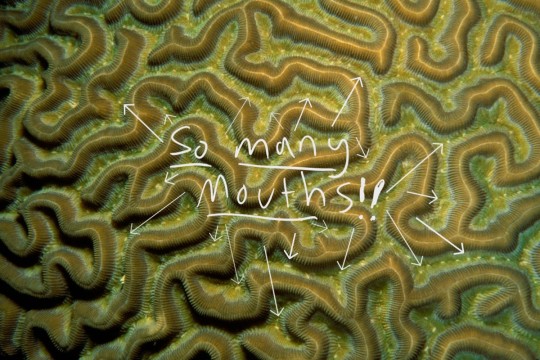
Fused polyps like on brain corals don't extend exactly, but feeder tentacles will come out from that delineation between the ridge and oral groove. It's actually called an oral groove! Those tentacles are full of the same stinging cells jellyfish and anemones have! One biologist referred to brain corals as a wall of mouths! Ive seen them using those tentacles to slowly drag struggling little shrimps and larval fish towards a slowly opening mouth amongst that wall of mouths! It's like living in a place where at night, the walls open mouths and drag you into them with unthinking stinging strings! Sometimes they just spit out digestive strings to digest stuff outside of their body, like other coral that got too close and needs to check itself! Isn't that great!
A lot of people are surprised to hear "mouths" and "feeding" with corals and yup, corals are animals and therefore they eat! Each polyp has a mouth and tentacles and will extend them to capture prey, mostly zooplankton but also some plant material. Because they're fucking weird though, many species also gain energy via photosynthesis with the help of a symbiotic dinoflagellate called the zooxanthellae or symbiodinium. It's this algae like symbiont that actually gives coral most of their colors. These colors can range from psychadelic to just brown, with regular old browns and greens and yellows being the most common colors (especially in the Caribbean).
A bleached coral is still alive, but due to stress has lost their zooxanthellae. They can survive and recover, but in this state they are highly stressed, prone to disease, and can starve slowly without the symbionts helping with their nutritional needs. They appear white or faded because the loss of their symbionts reveals the white calcium skeleton beneath the tissue.

Bleached portion of coral beside unbleached.
A dead coral is one that has lost all of it's tissue, and every individual polyp has died, leaving nothing but the skeleton which can no longer grow without the living polyps. Bleached coral is very, very vulnerable to becoming a dead coral.
Unusually high heat is the most common trigger for a bleaching event. And this is where, in my education talks I sometimes do, I pause with a strained grimace of a smile as we all contemplate ocean temperatures hiking up every summer.
SO WHY ARE THESE WEIRDASS ROCK ANIMALS IMPORTANT BESIDES BEING COOL TO LOOK AT?
Coral structure can be colloquially described as stony or soft. Stony corals are what I work with more, and these guys are the ones that build a hard, calcium based structure as their support building, and these powerhouses are the ones that build the coral reef. Soft corals are what it says on the tin, they may have a sort of support structure that varies amongst families, but it's flexible (you'll see them waving very beautifully and gracefully in the currents) and they (for the most part) do not build the reef. If they do add to reef building it, it's with a very slow process of depositing fine layers.
(Soft corals of course have their role in the overall reef health, but reefs are bonkers complicated ecosystems and I'm trying to keep on track here.)
When you're looking at the reef, you are looking on centuries, if not millennia, of stony corals building on top of each other. Sometimes this building has been going on for so long that islands are made of fossilized reefs from millions of years ago, with corals that still resemble modern species in the rock. (This is the case of BonAire and blew my goddamn mind seeing the fossil reef it's so fuckin cool.)
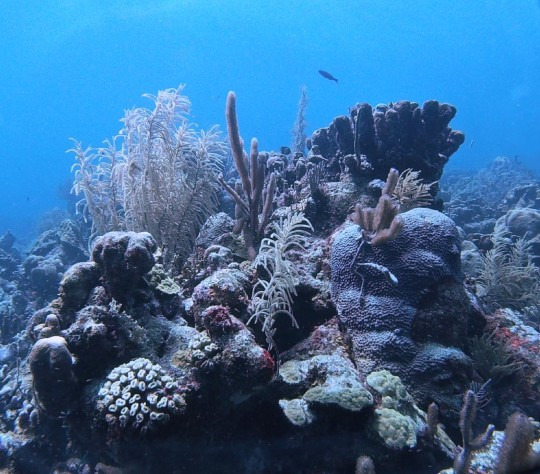
Sometimes just a single colony will keep building on itself into massive structures. Polyp clones adding on and on to their predecessors, giving the colony overall a lifespan in centuries. It's thought that some huge colonies may be thousands of years old, because the fastest growing stony corals have a growth rate that may equal centimeters per year.

It's those reef structures of calcium carbonate building up and up that provide the homes to so many other creatures that coral reefs are some of the most biologically diverse, and biologically dense ecosystems out there, like rainforests of the ocean. Even marine life that doesn't live directly in the reefs have a connection to them, using them as feeding grounds, breeding areas, a place to hide while young and vulnerable, ect.
They even protect coastlines, acting as a literal barrier that reduces wave damage from storms or just wave action in general. The reef takes the brunt of the physical damage, colonies get knocked around, but the still living polyps keep on building and rebuilding so the reef can go on and not get smashed into rubble every year.
That is, if there are still stony corals alive to do the rebuilding. :))))))

So you have these weird animals who build stone structures like cathedrals, have algae in their tissue, live as massive ancient colonies of clones that can eat, photosynthesize, and also reproduce both asexually and sexually. They're able to branch out and do all of that because they are adapted to insanely stable environments. Temperatures don't fluctuate by more than a couple degrees seasonally, tides are consistent, storm seasons are consistent, the water is consistently clear due to lack of algae, which allows sunlight to penetrate and feed the symbionts that feed the coral. Mineral levels in the water are stable so they can take the calcium and carbonate from the sea water to build their skeletons. Without having to be able to adjust to changes in the environment they just went hog fucking wild on all the ways an animal can be an animal.
And here I once again pause with a strained grimace smile as we all take in how they need to be alive to keep building those reefs that support the ocean and the coasts, and how not stable their environment is becoming with new pollutants clouding waters, storms becoming more unpredictable, and waters having bigger temperature swings with hot summer spikes. :)))))))))))
#long post#marine biology#coral reefs#informative#corals are freaks and i love them#i barely touched how theyre freaks i wanted to keep this to a simple 101 guide on what they are and why theyre important#and why they are. not doing too great.#in the grand scheme of the world i believe coral reefs as an ecosystem type will survive#a few species are super hardy#some are more adaptable#in millions of years the ones that made it will eventually find new suitable places to rebuild on the rubble of ruins#but also i would prefer NOT HAVING A CATASTROPHIC EXTINCTION EVENT FOR THEM TO RECOVER FROM OVER A FEW MILLION YEARS THANKS#I WOULD PREFER THAT SORT OF RUIN NOT MAKING LIVES HARDER FOR EVERYONE
75 notes
·
View notes
Text
Thoughts on Tokitae
Let me start by saying that I am not a professional in the field. I know many people who currently work or have worked at various SeaWorld parks. I know many people who have left the field and now have their own successful canine training business. I have had two internships in the field, and I am a current volunteer at a zoo with marine mammals where I’m practicing husbandry behaviors with lead trainers. I have done a ton of research on both sides, but I am by no means a professional. What I am about to say is purely my own opinion, however I am doing my absolute best to make my opinion based on factual evidence.

It was recently announced that Toki- better known by her stage name “Lolita”- is set to be returned to a sea pen in the pacific northwest where she was captured from over five decades ago.
Personally, I do not believe this is in the best interests of Toki.
I visited MSQ when I was down in Florida for college. As someone who grew up and had their passion for marine life inspired by visiting Seaworld, I can say in all fairness that MSQ is the first facility that I have gone to where I began to question the ethics of cetacean captivity. While I am a supporter of all AZA facilities and recognize the excellent work that they do for species conservation, and for the animals in their care, something about MSQ just felt very old school- and by that I mean very outdated facilities. I know there are so many permits to be obtained to start fixing things like outdated animal housing, but this brings up my first point.
The zoological community should absolutely have done something about Toki’s situation decades ago. It should never have gotten to this point. She needed a much larger facility, or to be moved, and that needed to be done years upon years ago. Mark Simmons said it best in one of the many podcasts he has been speaking on: The zoological community should be ashamed for letting it get to this point. Something should have been done. And it should have been done long, long ago.
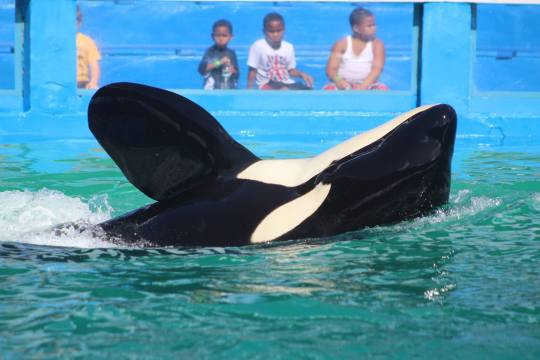
But now comes the issue of trying to release her- or move her to a sea pen to live out the remainder of her days (there seems to be confusion amongst the people funding this and those in charge over what the actual long term plan is). It is incredibly emotionally charged on both sides- from former trainers who want what is best for her, to individuals who have knowledge of wild orca but do not have experience with animals under human care and are not experts in behavior. Everyone wants what is best for her and no one wants to see her suffer. But there are issues with this particular plan, and I want to cover my own concerns (concerns that have been brought up by many other people as well)

Issue 1: This is a bureaucratic nightmare. I’m not even sure what all goes into this, but I know there’s a ton of permits that will be needed, a lot of things need to be mapped out and approved, it’s going to take time, it’s going to take money, and at any step in the process the whole thing could be scrapped for not being able to obtain one permit or another.
Issue 2: She nearly died last year from a respiratory illness. She’s clearly a survivor, and while I do believe she would survive the transport, the fact is that she is not a healthy animal at this point. She is being treated with daily medication, and will be introduced to pathogens that she is unfamiliar with in a sea pen. With her current issues, this could easily pose a threat to her life. Along with this point, she could bring pathogens into an environment that is already threatened by pollutants.
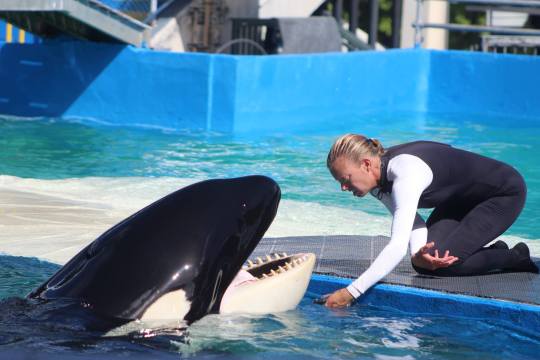
Issue 3: She was captured when she was roughly 4 years old. Over five decades of her life she has had her humans as her family. She is very habituated to them, and as seen with Keiko (who can be deemed a success or not depending on your viewpoint of the situation, in my opinion the release itself was a failure but the story would have been a success if there was funding to be able to keep him healthy in a sea pen vs pushing for full “freedom”). There is a lot to be said about learned behavior, and I believe that Toki is a very poor candidate for release.
Issue 4: Toki will be going from a tiny pool to a large sea pen. That change can be unbelievably overwhelming. IF they are committed to trying this, they really need to entertain an interim solution: like Keiko’s tank in Oregon. Then Toki would be given the chance to become more fit, get used to swimming more and diving deeper, and maybe they can see if she would be able to adjust to that- if she isn’t able to, then the next step of a sea pen would be out of the question.
Issue 5: The cost of it all. And this is my BIGGEST issue with this. Again, Toki’s situation needs to improve, and should have been improved decades ago. But what frustrates me to no end is that people are willing to poor millions into a single whale. One whale. I’m not saying her life isn’t important, however the millions of dollars being poured into a “swim off into the sunset” fantasy could be going towards any number of other issues facing our oceans. Or even go directly to the endangered southern residents.
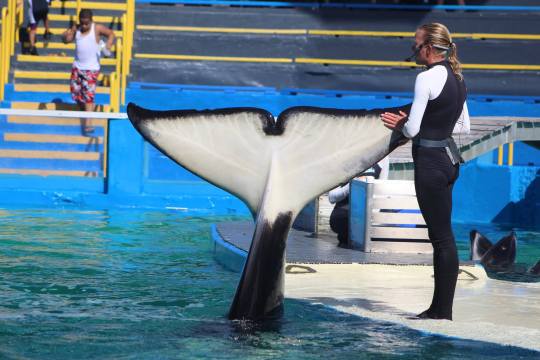
So what’s a good solution then? I mean, I honestly don’t know and I hope something will be done. Nobody wants her to stay in her current situation. I would suggest moving her to SeaWorld Orlando, but the issue with that is I can bet SeaWorld won’t get involved. They won’t want to be directly in the line of fire of animal rights activists yet again. I can imagine they would steer clear of the situation. Using the money to build her a much larger facility on property would also be ideal. It’s a complicated situation and I truly understand everyone from both sides. The trainer’s are passionate and heartfelt about wanting to save this animal that they love so dearly. But the people who wish to see her returned to her pod have just as much passion, even if it can sometimes be misguided by anthropomorphic values. Toki’s situation is not a good one. It needs to change. But I don’t believe such a drastic answer of her “going home” and being “released” is the solution either. I wish something was done years ago. I really, really do. And I just hope that whatever happens next doesn’t cost Toki her life.

#Miami Seaquarium#tokitae#lolita#orcas#killer whales#animal rights vs animal welfare#also these are all my photos so pls don't steal them!#sorry this got long whoops#it was supposed to be short
11 notes
·
View notes
Text
I'm gonna talk more about my setting, Steam Soul, because it makes me happy and I can't sleep.
If you're interested in a sort of steampunk-y fantasy world's magic system, hit the Read More.
Also, a quick CW for mention of needles, tattoos, death, and fictional fascism/colonialism.
Within the setting of Steam Soul, every living being that is alive and that has memories and emotions, has a soul.
Depending on the depth that these feelings and emotions have, a being's soul can be more "powerful", meaning that there is more of the base component of the soul required to "hold" all of those memories and emotions together.
This base component has no established name in setting, but I personally refer to it simply as Fuel. Basically, the more that a being has experienced, and the more that it has felt, the more Fuel is held within its soul.
This is important, as when said being dies by any means, the last exhalation contains the entirety of its soul, as a pale vapor. The coloration depends on the species, with most animals having a grey, transparent one, that is light enough to disperse from a slight breeze. Humans have a deep blue color, and Fawn souls, for instance (human/deer hybrids) have green.
If this vaporous soul is inhaled, it can be very damaging to one's body and mind. The afflicted will have vivid hallucinations of whatever soul was inhaled, and will enter a catatonic state until the hallucinations stop. In many cases, these effects can cause cardiac arrest, and prove fatal.
This vapor can be harvested, and processed to remove all of the memories and emotions, leaving only the Fuel. This Fuel has many purposes, including being highly flammable, sometimes explosively so. However, if properly treated, it can become a powerful healing balm or injection that can cause a being's body to rapidly regenerate.
However, this phenomena can only happen with very dense and powerful souls, so it mainly occurs from inhaling human or humanoid souls.
Soul vapors also tend to adhere to surfaces that they're around for long enough, with certain metals being far easier for them to bond to: brass, silver, and copper, to name a few.
This can also happen if the soul is inhaled, but it is far more risky and prone to failure. An individual is just as likely to regenerate someone else's body instead of their own, which results in rejection, and often death.
Due to the dangers of soul vapors, it is very common for any individual-especially one in a more dangerous profession-to have a gas mask or an equivalent on their person at all times. Even a very simple one is effective at stopping the inhalation of souls.
Now, to move on to how the ordinary human can perform magical acts.
Certain nonhuman species, such as Fawns, or Gylffians (avian humanoids), have innate magical abilities that must be tempered via discipline and training. Humans, however, lack this quality.
In the ancient history of the setting, Fawns cooperated with humans, and lived alongside them. During this time, the practice of Rune Carving reached a peak. This practice involved etching magical symbols into stone, and pouring the Fuel from animal souls into the stone to create a temporary magical object.
It was Humanity that suggested carving a similar-or often, identical-symbol into one's body. Traditionally, this was done with gradual scarring, but later tattoos were used as a less invasive and time-consuming method.
These tattoos were referred to as Brands, and they used the energy provided by both the human Soul and the body itself to influence reality, essentially warping it to the parameters of the Rune. This mimicked, in a small capacity, the reality-based magic that nonhuman were already capable of. This came at the cost of the user's stamina, as well as, in the case of overuse, their body. For instance, if a user with a Flame Spout Brand were to push themselves past their limits, their skin would catch fire, sometimes tearing as if burst from within.
The powers and benefits wrought from these Brands, however, far outweighed the costs. Or at least, that was the belief of humanity, who lived in a world of monsters and wild beasts, at the time.
Over two centuries before the events of my novel took place, there was a horrible conflict called the Cleanse. During it, a powerful totalitarian government wrested control of the known world, and eliminated or drove out anyone deemed to be a threat. This, of course, included all nonhumans, anyone who protected them, and those educated in the ancient history of human/nonhuman cooperation.
By the destruction of the past, this new government, led by a corporation named Endless Enterprises, sought to take control of the future.
Due to the massive loss of history and learning, many Rune designs were lost to time, some of them being lost forever. The surviving scholars and nonhumans formed a hidden civilization known as Adversa, which was named for the city of learning and knowledge that was razed to the earth by Endless Enterprises. As such, the greatest archives of history lay there, as well as the world's greatest understanding of Runic magic.
The term Brand came out of style, especially with the process of stone-carved Runes being lost in the conflict. As such, the tattoos that allow the wearer to alter reality according to their design and purpose are now simply called Runes.
They function primarily off of the user's emotions, and it takes a great deal of understanding about one's psychology to know what Runes are "compatible" with oneself. An Rune Setter will interview a person, give them a list of possible Runes that would be compatible with them, and then tattoo in the relevant symbols to the person.
Now, modern Runes do not use the Fuel from animal souls, but instead a crushed flower, that grows from Human Soul Vapors. This flower, known as the Memoir's Bloom, is carefully harvested, petal by petal, for use in Rune Setting.
Many properties of the Bloom are still unknown. It has a repellant effect on nonhumans, when powdered, although this is nothing more than a distinct discomfort, and nothing harmful. The flower will also take on a unique scent, based on the last thoughts of the person whose soul fueled it.
That's all I have to say at this moment, feel free to ask any questions you'd like, and, if youre seeing this, thank you for reading all of this. The setting of Steam Soul has been a passion of mine for almost 6 years, and I'm always happy to share my knowledge of it.
5 notes
·
View notes
Photo

NAME: Black Dog
RARITY: ★★★☆☆ | While some variants may be rare with little known about them, others can be locally well-known.
THREAT: ★★☆☆☆ | Most black dogs only frighten or portend misfortune with their appearance, not making themselves a physical threat. However, a couple of variants are notable for being predatory and lethal.
HABITAT: Most commonly seen in more rural, open habitats such as meadows or the sides of roads. Sometimes seen in the woods or around cemeteries. When seen in town, it’s generally only a glimpse in the dark.
DESCRIPTION: The descriptive and apt term of “black dog” refers to a category of dog-like creatures with black fur. They tend to roam outside of human settlements along roads or across farmland. Sometimes mistaken for stray dogs or even other canids, these creatures are shrouded in mystery, with some people believing them to be demonic entities, spectral beings, simple supernatural animals, or something from another world entirely. Despite black dogs making themselves known to humans frequently enough, there is so little known about them from just these fleeting glances, and as a result they’ve captured peoples’ imaginations… and fears. In some cases, a black dog will become so well-known in a locale that they’ll receive a nickname with their own legends being spun around them.
Perhaps some respect is warranted as some black dogs are known for being portents of misfortune or even death, and few others are outright malicious. Some theorize that the more dangerous variants of black dogs only differ from other less docile ones by their diet. That is, it’s possible all black dogs have similar lethal abilities they refrain from using. An equally compelling mystery is whether each type of black dog is a single individual or a population or if that varies, too.
TYPES:
Barghest: Seeing one of these large, midnight black dogs is considered to be a portent of misfortune – even death. Barghests only come out at night, and only when someone is alone. They tend to hang around churchyards and nearby wooded areas, especially if many people have died there recently. They have a clanking chain attached to one of their back legs which they drag across the ground; this sound may be the best clue that you’re being watched by one. Barghests have not been known to attack; they simply stare with piercing red eyes before loping away. Some think they’re banshees who were bitten by werewolves but there’s zero evidence of this. No weaknesses or ways to reverse the omen are known. There is a subspecies of barghest with slate grey fur that is similar but for one more difference: rather than acting as a bad omen for you, it’s acting as one for a loved one in your life. Debatable which type of barghest is worse to see… and it can be hard to tell the difference in the dark.
Black Shuck: Perhaps a species or perhaps an individual, Black Shuck is known to roam countryside and farmlands, and reports of this black dog span worldwide and have persisted for centuries. Said to be the size of a calf, Black Shuck has a large, single red eye, and its gaze gives onlookers chills for days. Black Shuck’s presence portends misfortune, but unlike the barghest, Black Shuck may play a part in fulfilling this prophecy. The leading theory is that Black Shuck is a cursed individual who has been made to wander for eternity as a monster, shedding off its misfortune bit by bit on those unlucky enough to look into its eye while it howls. No weaknesses are known, nor is there any hard evidence of this creature being the result of a curse other than a single vague poem dating back four centuries.
Church Grim: Also called the kirk grim, these black dogs are unique in that they’re most definitely specters. They cannot be seen by most, but those who can perceive ghosts would see a massive black dog with piercing white eyes. They’re thought to be the spirits of dogs who were buried on holy grounds, forever bound to act as a canine guardian of the premises. The location they’re tethered to is most often a chapel with a cemetery. They’ve been known to pull on peoples’ pant legs, knock people over, and urinate ectoplasm on tombstones. This is especially alarming for those who can’t see them. Church grims can be exorcised (if you really want to) or kept in line with salt. Groundskeepers may appreciate their presence – vampires less so. Those teeth can really shred up the undead. However, church grims will be loyal to whoever they perceive is taking the best care of the premises they protect.
Gurt Dog: Known to be benevolent black dogs, gurt dogs tend to be found more closely nestled in human settlements than other variants. These Great Dane like dogs act as guardians, watching over those they come to care for from afar. These may be travelers or campers on the road, but they’ve been known to keep watch over suburban homes as well. Sometimes an individual doesn’t even know a gurt dog has “chosen” them until their life is at stake, and the dog intervenes. Of course there’s a catch. Those being watched over by the gurt dog will have increasingly bad luck, requiring more and more intervention from the dog, creating a positive feedback loop of constant threats and chaos.
Gwyllgi: The most fiery of the black dogs, gwyllgi can grow to be the size of a cow, and their flame retardant fur grows long and shaggy. Their eyes burn like hot coals and immobilize anyone who looks into them, even just a passing glance. Their most dangerous asset is their flame-breath, which they use to barbeque their frozen victims. Most often seen patrolling along roadsides at night, gwyllgi are said to consume travelers and residents of towns they encounter along the way. Some have a particular road they patrol, while others are perpetual nomads that travel wherever a country’s highway system will take them. If you avoid the roads and don't look into their eyes, you’ll probably be fine. Hunters may be more familiar with gwyllgi than other black dogs because their behaviors bring them into conflict with humans. Rangers are immune to their gaze but not their flame, and they can be killed by conventional means.
Loophound: This black-coated dog will run circles around you, literally. Long and lithe like a sighthound, it can run as fast as a deer. They like wide open areas where they can run without impediment. At night, they’re known for bolting in and out of someone’s peripheral vision, staring with their bright white eyes for a brief moment before making you question whether you saw anything at all. Loophounds aren’t aggressive, but they are playful. And their favorite game is one that can curse you. They run loops around people, and each completed circuit bestows an increasingly strong curse. One loop may cause you merely to trip a few times, but 10 might give you a lifelong problem, and 20? That curse might become generational. If a loophound tries to engage you in this kind of play, you need to prevent it from moving somehow, and quickly.
Moddey Dhoo: With the appearance of a large, black spaniel, the moddey dhoo has a thick coat of black fur that’s constantly dripping wet and foul smelling. More than anything, it wants to dry off, so it seeks out warmth, and especially fire. Those camping out in the woods may attract this black dog’s attention. When it locates a source of warmth it desires, it responds with feral fury, tearing up any obstacles (including humans) who might rob it of heat. Putting out the fire will confuse the dog, as if it no longer even knows anyone is there; distancing oneself from the source of heat is risky (only the moddey dhoo knows how far away is enough for it) but it can calm it. Those who find themselves in close proximity to a moddey dhoo typically end up with some residual bad luck, to the flavor of being dripping wet for no reason, falling in bodies of water, or having their house flooded. This eventually wears off. They’ve been known to follow phoenixes around.
#monsters#beast#specter#magical#populated areas#meadows#woods#death#barghest#black shuck#church grim#gurt dog#gwyllgi#loophound#moddey dhoo#black dog
6 notes
·
View notes
Text

Day 24: Warp
My data pad has once again died. It should be able hold a charge for months and I just recharged it at the outpost not even three days ago. In that time, I was, fortunately, able to scan and learn the names of a few dozen animals that we already have on record as well as document those not yet in our system for later classification. But three days worth of data is not enough. It should've been able to make the whole journey on a single charge. Clearly something was wrong.
I had initially thought I had permanently damaged the battery back in the cave. It could've been damaged from the initial fall, or from using it to supplement Lily’s charge the entire way back. I have no clue how much power they draw and there was a good chance using it like that could’ve fried the battery. It was at this point I figured percussive maintenance of the device would be in order. Shaking it did nothing; however, calmly and rationally throwing it with all of my strength against a rock did help me figure out the issue.
The culprit was a new species of ray. Similar to the Cathode rays from deep within the cave, this new ray was also an electrovore. I'm not sure when I picked it up but it must’ve spent the past few days siphoning the charge from the data pad’s battery. And it did so in, easily, the most impressive forms of visual mimicry I've ever come across.
Earth has its own forms of mimics. From something simple like assorted leaf-tailed geckos, who's skin looks almost indistinguishable from the lichen they rest upon; to animals like the cuttlefish who can change their shape and texture to blend in with almost anything in their surroundings. Atria, however, is a world of extremes, and this species of ray has taken the simple rules of mimicry and pushed them to match that extreme.
It had pressed its body almost completely flat against the screen of my data pad, copying, not only the shape, but the texture of the screen too. It felt smooth, hard, and glassy the whole time I was using it despite being a soft-bodied animal with minimal bones. That's the most interesting thing; the fact that I was able to still use it. The animal was, somehow, not triggering any inputs while pressed against the touchscreen. It's very possible that this animal, having its entire biology built around consuming and manipulating electricity, would send a signal straight down from where I pressed on its back to act as the input trigger.
What really made this animal’s mimicry truly stand out is the degree to which it took bioluminescence. Many animals on Atria possess specialized organs that allow them to break down and utilize the glowing cells of bioluminescent algae for their own purpose. The Opticalaber Ray, however, isolates these cells into highly specialized photophores that give it the ability to change brightness, saturation, and even color of its bioluminescence. Somehow, this bizarre animal was able to warp the light from my screen and project onto its back the text and images of the screen below it almost perfectly.
Once the datapad had settled after bouncing off the rock, the opticalaber ray pried itself from the damaged screen. It seemed dazed for a moment but promptly began to float away from the spent energy source. I watched as it shifted the color of its underbelly to mimic the sky before it pressed itself onto a nearby rockface. Despite seeing where it landed, it was hard to accurately pinpoint its silhouette against the rock and bioluminescent algae it mimicked so perfectly. Getting a sample from the ray was even harder since its body became nearly as hard as the actual rock it mimicked.
I understand why mimicry is found so commonly in nature, and why near-defenseless, soft-bodied animals like squid and cuttlefish rely on it so heavily. But what I don't understand is why an animal, like this ray, evolved photomimicry to such a precise degree? Why does it need to have each cell that covers its body act as separate individual pixels that can all operate together? My number of resources that provide me any semblance of an answer is rapidly dwindling. Not to mention, the number of questions I have never stops rising.
[End Transcription]
1 note
·
View note
Text
Why the Age of American Progress Ended
— By Derek Thompson • Monday December 12, 2022

The Scourge of All Humankind
If you were, for whatever macabre reason, seeking the most catastrophic moment in the history of humankind, you might well settle on this: About 10,000 years ago, as people first began to domesticate animals and farm the land in Mesopotamia, India, and northern Africa, a peculiar virus leaped across the species barrier. Little is known about its early years. But the virus spread and, whether sooner or later, became virulent. It ransacked internal organs before traveling through the blood to the skin, where it erupted in pus-filled lesions. Many of those who survived it were left marked, disfigured, even blind.
As civilizations bloomed across the planet, the virus stalked them like a curse. Some speculate that it swept through ancient Egypt, where its scars appear to mar the mummified body of Pharaoh Ramses V. By the fourth century A.D., it had gained a foothold in China. Christian soldiers spread it through Europe during the 11th- and 12th-century Crusades. In the early 1500s, Spanish and Portuguese conquistadors conveyed it west across the Atlantic, where it ravaged native communities and contributed to the downfall of the Aztec, Mayan, and Inca empires.
By the end of the 1500s, the disease caused by the virus had become one of the most feared in the world. About a third of those who contracted it were dead within weeks. The Chinese called it tianhua, or “heaven’s flowers.” Throughout Europe, it was known as variola, meaning “spotted.” In England, where doctors used the term pox to describe pestilent bumps on the skin, syphilis had already claimed the name “the great pox.” And so this disease took on a diminutive moniker that belied the scale of its wretchedness: smallpox.
Over time, different communities experimented with different cures. Many noticed that survivors earned lifetime immunity from the disease. This discovery was passed down through the generations in Africa and Asia, where local cultures developed a practice that became known as inoculation—from the Latin inoculare, meaning “to graft.” In most cases, people would stick a sharp instrument into a smallpox-infected pustule to collect just a little material from the disease. Then they would stick the same blade, wet with infection, into the skin of a healthy individual. Inoculation often worked—pustules would form at the injection site, and a low-grade version of the disease would typically follow. But the intervention was terribly flawed; it killed about one in every 50 patients.
Not until the early 1700s did a chance encounter in the Ottoman empire bring the process to Britain, and bend the axis of history. In 1717, Lady Mary Wortley Montagu, an English aristocrat living in Constantinople with her husband, a diplomat, heard about inoculation from her acquaintances in the Ottoman court. Circassian women, from the Caucasus Mountains and in great demand for the Turkish sultan’s harem, were inoculated as children in parts of their bodies where scars would not easily be seen. Lady Montagu asked the embassy surgeon to perform the procedure on her son—and upon her return to London a few years later, on her young daughter.
Word spread from court physicians to members of the College of Physicians to doctors across the continent. Within a few years, inoculation had become widespread in Europe. But many people still died of smallpox after being deliberately infected, and in some cases inoculation transmitted other diseases, like syphilis or tuberculosis.
One boy who went through the ordeal of inoculation was Edward Jenner, the son of a vicar in Gloucestershire, England. He trained as a physician in the late 1700s, and carried out these rough smallpox inoculations regularly. But Jenner also sought a better cure. He was taken by a theory that a disease among cows could provide cross-immunity to smallpox.
Want to discuss the future of business, technology, and the future of progress? Join Derek Thompson and other experts for The Atlantic’s first Progress Summit in Los Angeles on December 13. Free virtual and in-person passes available here.
In the spring of 1796, Jenner was approached by a dairymaid, Sarah Nelmes, who complained of a rash on her hand. She told Jenner that one of her cows, named Blossom, had recently suffered from cowpox. Jenner suspected that her blister might give him the opportunity to test whether cowpox was humanity’s long-awaited cure.
May 14, 1796, was a golden day in the history of science but a terrifying one for a certain 8-year-old boy. Jenner drew a blade, slick with ooze from a cowpox blister, across the arm of James Phipps, the brave and healthy son of his gardener.
After a week, young James developed a headache, lost his appetite, and came down with chills. When the boy had recovered, Jenner returned with a new blade—this one coated with the microbial matter of the smallpox virus. He cut the boy with the infected lancet. Nothing happened. The boy had been immunized from smallpox without encountering the disease.
Jenner would go down in history as the person who invented and administered a medical cure for one of the deadliest viruses in world history. Then he invented something else: a new word, from the Latin for “cow,” that would be carried down through the centuries alongside his scientific breakthrough. He called his wondrous invention a vaccine.

Illustrations by Derek Brahney
The Eureka Myth
Let’s pause the story here. Jenner’s eureka moment is world-famous: cherished by scientists, rhapsodized by historians, and even captured in oil paintings that hang in European museums.
For many, progress is essentially a timeline of the breakthroughs made by extraordinary individuals like Jenner. Our mythology of science and technology treats the moment of discovery or invention as a sacred scene. In school, students memorize the dates of major inventions, along with the names of the people who made them—Edison, light bulb, 1879; Wright brothers, airplane, 1903. The great discoverers—Franklin, Bell, Curie, Tesla—get best-selling biographies, and millions of people know their names.
This is the eureka theory of history. And for years, it is the story I’ve read and told. Inventors and their creations are the stars of my favorite books about scientific history, including The Discoverers, by Daniel Boorstin, and They Made America, by Harold Evans. I’ve written long features for this magazine holding up invention as the great lost art of American technology and the fulcrum of human progress.
But in the past few years, I’ve come to think that this approach to history is wrong. Inventions do matter greatly to progress, of course. But too often, when we isolate these famous eureka moments, we leave out the most important chapters of the story—the ones that follow the initial lightning bolt of discovery. Consider the actual scale of Edward Jenner’s accomplishment the day he pricked James Phipps in 1796. Exactly one person had been vaccinated in a world of roughly 1 billion people, leaving 99.9999999 percent of the human population unaffected. When a good idea is born, or when the first prototype of an invention is created, we should celebrate its potential to change the world. But progress is as much about implementation as it is about invention. The way individuals and institutions take an idea from one to 1 billion is the story of how the world really changes.
And it doesn’t always change, even after a truly brilliant discovery. The 10,000-year story of human civilization is mostly the story of things not getting better: diseases not being cured, freedoms not being extended, truths not being transmitted, technology not delivering on its promises. Progress is our escape from the status quo of suffering, our ejection seat from history—it is the less common story of how our inventions and institutions reduce disease, poverty, pain, and violence while expanding freedom, happiness, and empowerment.
It’s a story that has almost ground to a halt in the United States.
In theory, the values of progress form the core of American national identity. The American dream is meant to represent that exception to the rule of history: Here, we say, things really do get better. For much of the 19th and 20th centuries, they did. Almost every generation of Americans was more productive, wealthier, and longer-lived than the one before it. In the past few decades, however, progress has faltered—and faith in it has curdled. Technological progress has stagnated, especially in the nonvirtual world. So have real incomes. Life expectancy has been falling in recent years.

Derek Brahney © Provided by The Atlantic
What went wrong? There are many answers, but one is that we have become too enthralled by the eureka myth and, more to the point, too inattentive to all the things that must follow a eureka moment. The U.S. has more Nobel Prizes for science than the U.K., Germany, France, Japan, Canada, and Austria combined. But if there were a Nobel Prize for the deployment and widespread adoption of technology—even technology that we invented, even technology that’s not so new anymore—our legacy wouldn’t be so sterling. Americans invented the first nuclear reactor, the solar cell, and the microchip, but today, we’re well behind a variety of European and Asian countries in deploying and improving these technologies. We were home to some of the world’s first subway systems, but our average cost per mile for tunnel projects today is the highest in the world. The U.S. did more than any other nation to advance the production of the mRNA vaccines against COVID-19, but also leads the developed world in vaccine refusal.
At its worst, the eureka theory distorts American views of how best to push society forward, and slows material advance in the process. To appreciate the deeper story of progress—and to see how it bears on America’s own problems in the 21st century—let’s return to 1796 and recall how history’s first vaccine went global.
One to 1 Billion
After Edward Jenner verified that James Phipps was indeed protected against smallpox, he wrote a brief paper to announce his discovery. The Royal Society of London refused to publish it. His own self-published booklet, An Inquiry Into the Causes and Effects of the Variolae Vaccinae, was initially ignored by the medical community. (Jenner was both a physician and a zoologist, and his studies of cuckoo-bird behavior may have stoked suspicions that he was at best a dilettante, and perhaps something of a cuckoo himself.)
Jenner needed surrogates in the English medical field to give his wild experiments gravitas. He found one such defender in Henry Cline, an open-minded London surgeon who acquired some inoculating substance from Jenner and began conducting trials to confirm Jenner’s findings, establishing the practice as safe and reliable. The vaccine was so immediately and obviously successful that it proved self-recommending. By 1800, vaccinations had spread rapidly through Europe, in large part because so many elites supported them. The kings of Denmark, Spain, and Prussia personally promoted the vaccine. The pope called it “a precious discovery” that ought to restore the public’s faith in God.
Still, doctors faced a prodigious challenge: how to deliver the stuff around the world in an era without cold storage, airplanes, or cars. They settled on distribution methods that were, by any reasonable estimation, extremely strange and a little ingenious. In the early 1800s, Spain recruited 22 orphaned boys to bring the vaccine to the Americas on their body. Two boys were vaccinated immediately before their ship’s departure. When pustules appeared on their arms, doctors scraped material from them to jab two more children on board. Doctors continued this daisy-chain routine until the ship reached modern-day Venezuela, where they began using the most recent pox eruption to vaccinate people in the Americas. Without any advanced storage technology, they had managed to transport history’s first vaccine more than 4,000 miles, in perfect condition. Arm-to-arm, the vaccine traveled to Mexico, Macau, and Manila. Within 10 years of Jenner’s paper, the vaccine had gone global.
The smallpox vaccine faced popular resistance wherever it went. (In Britain, one cartoonist depicted the vaccinated as sprouting miniature cows out of their bodies.) But America’s most powerful people, including priests and presidents, typically extolled the virtues of the vaccine, having personally witnessed its benefits, which helped overcome the anti-science skepticism. Gradually, the vaccine pushed smallpox out of Europe and the U.S.
Even so, in the 1950s—some 150 years after Jenner’s discovery—1.7 billion people, or roughly 60 percent of the world’s population, still lived in countries where the virus was endemic. The major powers would often talk about finishing the job of smallpox eradication, but major technical and organizational obstacles stood in the way. Vaccination efforts still lacked funding. Outbreaks were still too difficult to track.
Then along came several heroes who belong in the pantheon of science history alongside Edward Jenner. The first is D. A. Henderson, the director of the World Health Organization’s global vaccination effort. Henderson was just 38 years old when he arrived in Geneva to lead a program to vaccinate more than 1 billion people in 50 countries within 10 years. He was put in charge of a small staff and a modest budget within the labyrinth of a global bureaucracy.
Reaching 1 billion people with limited resources required a brilliant strategy for surveilling and containing the disease. Henderson’s team invented the technique of “ring vaccination.” Rather than inoculate every person in every country, his disease detectives would look for an outbreak and vaccinate all the contacts of the affected people and anyone else in the area. And so, each outbreak was encircled by people who were immune to the smallpox virus and wouldn’t let it pass through them.
Above all, Henderson needed an extraordinary supply of vaccine at a cheap price with a low-cost way to administer doses to people around the world. He benefited from a timely invention that proved essential to the story of smallpox eradication. In 1965, an American microbiologist named Benjamin Rubin created a bifurcated needle, which held a tiny droplet of vaccine between two prongs, like a miniature olive fork. It allowed 100 vaccinations from a single vial (four times the previous amount) and brought down the cost of vaccination to about 10 cents a patient.
Henderson and his small army of eradicators eventually squeezed smallpox out of Africa, South Asia, and Brazil. Since October 26, 1977, no naturally occurring smallpox cases have been recorded. In 1980, the WHO announced that smallpox, which had killed about 300 million people in the 20th century alone, had finally been eradicated.
Invention Without Implementation
The end of smallpox offers a usefully complete story, in which humanity triumphed unequivocally over a natural adversary. It’s a saga that offers lessons about progress—each of which pertains to America today.
The most fundamental is that implementation, not mere invention, determines the pace of progress—a lesson the U.S. has failed to heed for the past several generations. Edward Jenner’s original vaccine could not have gone far without major assistance from early evangelists, such as Henry Cline; distribution strategies to preserve the vaccine across the Atlantic; and a sustained push from global bureaucracies more than a century after Jenner’s death.
Almost every story of progress is at least a little like this, because even the most majestic breakthroughs are typically incomplete, expensive, and unreliable. “Most major inventions initially don’t work very well,” the economic historian Joel Mokyr told me. “They have to be tweaked, the way the steam engine was tinkered with by many engineers over decades. They have to be embodied by infrastructure, the way nuclear fission can’t produce much energy until it’s inside a nuclear reactor. And they have to be built at scale, to bring down the price and make a big difference to people.”
For many decades, the American government has focused overwhelmingly on discovery rather than deployment. After World War II, Vannevar Bush, the architect of our thrillingly successful wartime tech policy, published an influential report, “Science: The Endless Frontier,” in which he counseled the federal government to grow its investment in basic research. And it did. Since the middle of the 20th century, America’s inflation-adjusted spending on science and technology, through the National Institutes of Health and the National Science Foundation, has increased by a factor of 40.
But the government hasn’t matched that investment in the realm of implementation. This, too, was by design. Bush believed, with some reason, that politicians should not handpick nascent technologies to transform into new national industries. Better to advance the basic science and technology and let private companies—whose ears were closer to the ground—choose what to develop, and how.
You could say that we live in the world that Bush built. “The federal government, through NIH and NSF, pours billions into basic science and defense technology,” Daniel P. Gross, an economist at Duke University, told me. “But for civilian technology, there has been a view that Washington should fund the research and then get out of the way.”
As a result, many inventions languish in the so-called valley of death, where neither the government nor private ventures (risk-averse and possessed by relatively short time horizons) invest enough in the stages between discovery and commercialization. Take solar energy. In 1954, three American researchers at Bell Labs, the R&D wing of AT&T, built the first modern solar-cell prototype. By 1980, America was spending more on solar-energy research than any other country in the world. According to the Bush playbook, the U.S. was doing everything right. But we lost the technological edge on solar anyway, as Japan, Germany, and China used industrial policy to spur production—for example, by encouraging home builders to put solar panels on roofs. These tactics helped build the market and drove down the cost of solar power by several orders of magnitude—and by 90 percent in just the past 10 years.
The U.S. remains the world’s R&D factory, but when it comes to building, we are plainly going backwards. We’ve lost out on industrial opportunities by running Bush’s playbook so strictly. But there are other problems, too. Since the early 2000s, the U.S. has closed more nuclear-power plants than we’ve opened. Our ability to decarbonize the grid is held back by environmental regulations that ironically constrict the construction of solar- and wind-energy farms. It’s been roughly 50 years since Asia and Europe built their first high-speed rail systems, but the U.S. is almost comically incapable of pulling train construction into the 21st century. (A 2008 plan to build a high-speed rail line in California has seen estimated costs more than triple and deployment delayed by a decade, and it’s still uncertain if it can be completed as planned.)
“New ideas are getting harder to use,” the futurist and economist Eli Dourado told me. If the U.S. wanted to unleash geothermal power, we could simplify geothermal permitting. If we wanted to build the next generation of advanced nuclear reactors, we could deregulate advanced nuclear reactors. These measures would not require inventing anything new. But they would stimulate progress by making it easier to bring our best ideas into the light.
The United States once believed in partnerships among the government, private industry, and the people to advance material progress. The Lincoln administration helped build the railroads. The New Deal helped electrify rural America. Dwight Eisenhower signed the Price-Anderson Act, which guaranteed government funds and limited liability for nuclear-energy firms in case of serious accidents, facilitating the construction of nuclear-power plants. John F. Kennedy’s space ambitions made NASA a major consumer of early microchips, which helped reduce their price by a factor of 30 in a matter of years, accelerating the software revolution.

Derek Brahney © Provided by The Atlantic
“And then, around 1980, we basically stopped building,” Jesse Jenkins, who researches energy policy at Princeton, told me. In the past 40 years, he said, the U.S. has applied several different brakes to our capacity to build what’s already been invented. Under Ronald Reagan, the legacy of successful public-private partnerships was ignored in favor of the simplistic diagnosis that the government was to blame for every major problem. In the ’70s, liberals encouraged the government to pass new environmental regulations to halt pollution and prevent builders from running roughshod over low-income neighborhoods. And then middle-class Americans used these new rules to slow down the construction of new housing, clean-energy projects—just about everything. These reactions were partly understandable; for example, air and water pollution in the ’70s were deadly crises. But “when you combine these big shifts, you basically stop building anything,” Jenkins said.
To understand how we could do better, it’s useful to compare the story of the first global vaccine to the story of the latest one.
Warp Speed
In April 2020, as COVID was circumnavigating the globe and demolishing normalcy everywhere, The New York Times published an article titled “How Long Will a Vaccine Really Take?” Although Trump-administration officials aimed to unveil a COVID vaccine within 18 months—that is, by the fall of 2021—the journalist Stuart Thompson reminded readers that the shortest time in history for developing a new vaccine was four years. “The grim truth,” he wrote, “is that a vaccine probably won’t arrive any time soon.” But then it did. The first mRNA vaccines were administered before the end of 2020.
The COVID vaccines underline a second lesson from the smallpox story. Some technology myths make it seem like progress is exclusively the work of geniuses, untouched by the grubby hands of politicians and bureaucrats. But a rogue cadre of inventors didn’t eradicate smallpox. States did. Agencies did. Progress is often political, because the policy decisions of states and international organizations frequently build the bridges between discovery and deployment.
The story of the mRNA vaccines can be traced back to the ’90s, when the Hungarian-born scientist Katalin Karikó began her research on the pharmaceutical potential of mRNA, a small but mighty molecule that tells our cells what proteins to make. Her work, along with that of her fellow University of Pennsylvania researcher Drew Weissman, gradually raised our mastery of mRNA to the point where it could be deployed for a vaccine. In early 2020, within 48 hours of receiving the genetic sequencing of the coronavirus, Moderna had prepared its COVID-vaccine recipe, and BioNTech, a German firm that later partnered with Pfizer, had designed its own vaccine candidate.
These technological breakthroughs, building on decades of basic research, were themselves miracles. But alone, they weren’t enough. The U.S. also needed a policy miracle—a feat of bureaucratic ingenuity that would make, distribute, and administer novel vaccines with record-breaking efficiency. We got just that with Operation Warp Speed, which belongs with the Apollo program and the Manhattan Project as one of the most important technology programs in the history of modern federal policy. It likely saved hundreds of thousands, if not millions, of lives.
From the beginning, Warp Speed’s job seemed nearly impossible. To create the fastest vaccine program ever, officials had to essentially map out the entire journey of a new therapy—from research and clinical trials to regulatory approval and distribution—and turn this obstacle course into something like a glide path. They invested in both traditional and mRNA vaccine approaches, paid up front for clinical trials, and placed billions of dollars in advance orders to urge pharmaceutical companies to move as fast as possible. When Moderna needed more manufacturing facilities, Warp Speed provided funding for additional factory space. When the government identified a shortage of the special material that mRNA vaccines require for ultracold transport, Warp Speed granted $347 million to SiO2 and Corning, two manufacturers of glass vials. And because standard vaccine approval from the FDA can take years, the program’s leaders allowed vaccine makers to proceed with emergency use authorizations to speed up the review process.
“The single most important thing that Operation Warp Speed did was to provide a whole-of-government urgency” to the goal of rapid deployment, Caleb Watney, a co-founder of the Institute for Progress, told me. “Getting everything right meant you needed to make a million correct decisions in the right order.” If the government had bet only on traditional vaccine technology, we would have had no mRNA therapies. If the government hadn’t done extensive supply-chain mapping in the summer of 2020, the initial vaccine rollout might have taken months rather than weeks. And if the government hadn’t bought out vaccines from the pharmaceutical companies, they wouldn’t have been free to consumers. But because Operation Warp Speed did all of this, the vaccines were expeditiously approved, manufactured, and distributed at no cost to the public.
Warp Speed was a special case, essentially a wartime policy applied to a health crisis. Few people would recommend such an aggressive approach for developing ordinary consumer technology. And the government is certainly capable of making bad choices as to exactly what technology to develop, and how. But while too much government action on this front can waste money, too little can waste time and even lives, stymieing possible breakthroughs. Warp Speed showed that smart government action can accelerate discovery and deployment. Just as significant, it showed that the kinds of bets the government can place, such as FDA reforms, don’t necessarily involve spending any money at all.
Here’s a thought experiment: Let’s imagine what an Operation Warp Speed for cancer prevention would look like. It might include not only a larger cancer-research budget, but also a search for regulatory bottlenecks whose elimination would speed up the approval of preventative drugs that have already been developed. According to Heidi Williams, the director of science policy at the Institute for Progress, from the time the War on Cancer was announced, in 1971, until 2015, only six drugs were approved to prevent any cancer. This reflects an enormous gap in clinical trials: From 1973 to 2011, nearly 30,000 trials were run for drugs that treated recurrent or metastatic cancer, compared with fewer than 600 for cancer prevention. How could this be?
You could start by blaming the U.S. system of patents and clinical trials, Williams told me. If a company discovers a drug that, when used by younger adults, prevents colon cancer in middle age, it could still take decades to gather long-term data from clinical trials. At that point, the patent on the original discovery might have expired. Reforming trials for preventative drugs and for early-stage disease therapies “might be the single highest-value thing we could do for biomedical research in the U.S.,” Williams said. The FDA already approves heart-disease treatments, such as beta-blockers, by looking at patients’ cholesterol levels rather than waiting for full mortality results. The agency could similarly establish short-term proxies for approving drugs that prevent cancers, Williams said. Or we could change the law so that the patent clock on cancer-prevention treatments didn’t start ticking until after the pharmaceutical company first starts selling the drug. As with Warp Speed, these policies could accelerate the development of lifesaving medication without spending a taxpayer dime on research. The key is adopting a more aggressive problem-solving approach, with the ends in mind.
One regrettable feature of history is that it sometimes takes a catastrophe to fast-forward progress. The U.S. directly advanced airplane technology during World War I; radar, penicillin manufacturing, and nuclear technology during World War II; the internet and GPS during the Cold War; and mRNA technology during the pandemic. A crisis is a focusing mechanism. But it is up to us to decide what counts as a crisis. The U.S. could announce a Warp Speed for heart disease tomorrow, on the theory that the leading cause of death in America is a national crisis. We could announce a full emergency review of federal and local permitting rules for clean-energy construction, with the rationale that climate change is a crisis. Just as it did in the ’60s with smallpox, the U.S. could decide that a major disease in developing countries, such as malaria, deserves a concerted global coalition. Even in times without world wars and pandemics, crises abound. Turning them into national priorities is, and has always been, a political determination.
A Question of Culture
Operation Warp Speed was ingenious, admirable, and wildly successful. But despite all that, it was not enough.
Having overcome the hurdles of scientific breakthrough, technological invention, and rapid distribution, the mRNA vaccines faced a final obstacle: cultural acceptance. And the skepticism of tens of millions of American adults proved too much for the vaccines to overcome. This is the third lesson of the smallpox story—culture is the true last-mile problem of progress. It doesn’t matter what you discover or invent if people are unwilling to accept it.

Derek Brahney © Provided by The Atlantic
In 2021, the U.S. took an early global lead in vaccine distribution, thanks to the accelerated development of vaccines under President Donald Trump and their timely delivery under President Joe Biden. By April, we had distributed more shots per capita than almost any other country in the world. But by September, according to one estimate, the U.S. had fallen to 36th in national vaccination rates, behind Mongolia and Ecuador. The problem wasn’t supply, but demand. Tens of millions of American adults simply refused a free and effective vaccine in the middle of a pandemic.
Michael Bang Petersen, a Danish researcher who led a survey of attitudes in Western democracies about COVID-19, told me that America’s history of vaccine skepticism—and of conspiracy theories surrounding vaccines—of course predates the coronavirus pandemic. And although American vaccine resistance has several sources, including the cost of some vaccines and our legacy of medical racism, Petersen told me that one of the most important factors today is “the level of polarization between Democratic and Republican elites.” Vaccine rejection remains higher among Republican adults than any other measured demographic, including age, education level, gender, and ethnicity.
In the 19th century, state and church leaders across Europe and the Americas typically praised the smallpox vaccine in unison. But in the 21st century, a dwindling number of subjects enjoy such universal elite endorsement. Despite the historical assumption that moments of tragedy bring a country together, the pandemic efficiently sorted Americans into opposing camps—for and against lockdowns, for and against vaccines. Nearly 90 percent of Americans told the Pew Research Center that the pandemic has made the country more divided.
Americans are deeply polarized; that much is obvious. Less obvious, and more important for our purposes, is how polarization might complicate material progress today. One big problem the country faces is that as coastal, educated elites have come to largely identify as Democrats, Republicans have come to feel ignored or condescended to by the institutions populated by the former group. As if recoiling from the rise of a liberal scientific and managerial class, the GOP has become almost proudly anti-expertise, anti-science, and anti-establishment. Cranks and conspiracy theorists have gained prominence in the party. It is hard to imagine scientific institutions flourishing within right-wing governments averse to both science and institutions. But this is only part of the problem, culturally speaking.
The other part is that some Democrats—many of whom call themselves progressives—have in meaningful ways become anti-progress, at least where material improvement is concerned. Progress depends on a society’s ability to build what it knows. But very often, it’s progressives who stand against building what we’ve already invented, including relatively ancient technology like nuclear power or even apartment buildings. Cities and states run by Democrats have erected so many barriers to construction that blue metro areas are now where the housing crisis is worst. The five states with the highest rates of homelessness are New York, Hawaii, California, Oregon, and Washington; all are run by Democrats. Meanwhile, it is often left-leaning environmentalist groups that use onerous rules to delay the construction of wind and solar farms that would reduce our dependency on oil and gas. The left owns all the backpack pins denouncing the oil industry, but Texas produces more renewable energy than deep-blue California, and Oklahoma and Iowa produce more renewable energy than New York.
One possible explanation is that progressives have become too focused on what are essentially negative prescriptions for improving the world, including an emphasis on preservation and sacrifice (“reduce, reuse, recycle”) over growth (“build, build, build”). At the extreme, this ascetic style leads to calls for permanent declines in modern living standards, a philosophy known as “degrowtherism.” The aim is noble: to save our descendants from climate change by flying less, traveling less, buying less, and using less. But it is a profound departure from progressivism’s history, which is one of optimism about the ability of society to improve lives on a big scale through bold action. It’s self-defeating to tell voters: “My opponent wants to raise your living standards, but I promise I won’t let that happen.” It’s far better—and, arguably, more realistic—to tell voters that building more renewable power is a win-win that will make energy cheaper and more abundant.
When you add the anti-science bias of the Republican Party to the anti-build skepticism of liberal urbanites and the environmentalist left, the U.S. seems to have accidentally assembled a kind of bipartisan coalition against some of the most important drivers of human progress. To correct this, we need more than improvements in our laws and rules; we need a new culture of progress.
The Trust Gap
A famous theme in American history is adaptability, and justifiably so. When something isn’t working, we’ve typically been game to try something new. In the summer of 2022, Biden signed a series of laws, including the CHIPS and Science Act and the Inflation Reduction Act, that included hundreds of billions of dollars for building microchips, solar panels, electric cars, and infrastructure, green and otherwise. In an address touting this approach, Treasury Secretary Janet Yellen branded it “modern supply-side economics.” Contrasted with the Reagan-era phrase, which referred to cutting taxes to stimulate the economy, her speech focused more on direct investments in American manufacturing and improving America’s ability to build what it invents. In October, Brian Deese, a senior adviser to Biden, announced the administration’s plans to deliver a modern industrial strategy that would help “spur mature technologies to deploy more quickly [and] pull emerging innovations to market faster.”
No one can say for sure how well Biden’s specific plans will work—and a decade from now, critics will undoubtedly find particular initiatives that failed or wasted money. Still, we might be moving from the eureka theory of progress to an abundance theory of progress, which focuses on making our best ideas affordable and available to everyone. Overall, this new direction of federal policy seems promising.
Still, it doesn’t solve the problem of cultural unreadiness for progress, a problem that afflicts the left and right differently, but that ultimately comes down to trust. Every form of institutional trust is in free fall. Fewer than half of Republicans say they have faith in higher education, big businesses, tech firms, media, the entertainment industry, and unions. Among Democrats, too, confidence in government has declined. Why is social trust so important to progress? In a country where people don’t trust the government to be honest, or businesses to be ethical, or members of the opposite party to respect the rule of law, it is hard to build anything quickly and effectively—or, for that matter, anything that lasts.
One of the most important differences between invention and implementation is that the former typically takes place in private while the latter is necessarily public. The first practical silicon-solar-cell technology was developed in a corporate lab in New Jersey. Building a solar farm to generate electricity requires the sustained approval of officials and local residents—in other words, it requires people to genuinely believe that they will benefit, at least collectively, from changes to their lived environment.
I want to tell you that there is a simple agenda for restoring trust in America, but I don’t think I can do that. When discussing barriers to the construction of nuclear-power plants or the pace of drug development, one can play the part of a bottleneck detective—identifying obstacles to progress and working to overcome them through clever policy tweaks. But Americans’ growing mistrust of institutions and one another is rooted in the deepest hollows of society: in geographical sorting that physically separates liberals and conservatives; in our ability to find ideological “news” that flatters our sensibilities but inhibits compromise.
In 2022, the medical journal The Lancet published an analysis of which variables best predicted the rates of COVID infection across 177 countries. Outside wealth, one of the most powerful variables was trust in government among the public. “Trust is a shared resource that enables networks of people to do collectively what individual actors cannot,” the authors of the Lancet paper wrote. When I first read their definition, I stared at it for a while, feeling the shock of recognition. I thought of how much that could serve as a definition of progress as well: a network of people doing collectively what individual actors cannot. The stories of global progress tend to be the rare examples where science, technology, politics, and culture align. When we see the full ensemble drama of progress, we realize just how many different people, skills, and roles are necessary.
The last needle to be applied against smallpox, before its eradication almost half a century ago, carried a dose of vaccine smaller than a child’s pupil. Four hundred years fit inside that droplet. The devotion of D. A. Henderson’s disease-eradicating team was in it. So were the contributions of Benjamin Rubin and the Spanish boys, as well as the advocacy of Henry Cline and the discovery by Edward Jenner, and before him the evangelism of Lady Montagu, and the influence of Circassian traders from the Caucasus Mountains, who first brought the practice of inoculation to the Ottoman court. An assembly line of discovery, invention, deployment, and trust wound its way through centuries and landed at the tip of a needle. Perhaps there is our final lesson, the one most worth carrying forward. It takes one hero to make a great story, but progress is the story of us all.
— This article appears in the January/February 2023 print edition with the headline “The Eureka Theory of History Is Wrong.”
0 notes
Note
My brain still hurts from the update. I’m just really baffled they thought the new species had anything special enough to be added, so since I’m kinda huffy let me rant a little bit.
Too many of these species just look like a different kind of Nitpicki, and I didn’t even like those to begin with. Their lore? Honestly laughably vague. (Like most of em but they don’t even have any particular intrigue)
Fabremon? Boring, we already have “inorganic species made with magic” with a bunch of companions. In concept they’re too similar to fuwa bozu and in design they’re basically just “small animal in hood”. Their lore? Weirdly not about them? It mentions how Faerilees went to war with chaotic forces and how fallen Allies would be resurrected to fight their friends in monstrous plush bodies, and like, huh??? Absolutely NOTHING on the Faerilee page mentions this shit but here it all is on the Fabremon one! Oh but don’t worry, Fabremon aren’t actually those things, they’re just recreations of that genuinely awful concept using purified gemstones that put a (still sometimes unwilling???) soul into their body! How charming. /s No but really who invented them, because you’d think the Faerilees would, I dunno, hate that???
Speaking of Faerilees, you can really tell this is a species geared towards Minka’s cutesie style because they have zero substance outside of that. Supposedly born from dandelions, their baby forms are fluffy puffs, but they do not have anything to do with dandelions in their design after that. Unlike that weirdly dark mention in the Fabremon page, their own origin is just this fluffy 3 sentences about a child making a wish.
I didn’t realize Galibytes were primates until I read the page. They look, again, like a Nitpicki. I’m really not sure how magic works in Lyth because apparently even though they have cores, they can’t do magic. Cool, glad we’re throwing out another consistent through-line. Glad nobody gets to know whether lyth has consistent worldbuilding or not. (Well, they have magic I guess, they just have so little that they can’t do shit with it) Also? Can I just say? I hate how they name individual species specific magic energy because it’s just dumb terms like “magnet” or “photo”. Personal pet peeve but it just feels so lazy to me because they sound ridiculous. Also why slime…why are they made of slime… “born from a puddle of specialized primordial soup” tells me fucking nothing. They’re apparently not even from lyth, so did they bring their weird soup with them after their world DIED apparently?
Moving on because I realize I’m rambling too long. I think Veela look like companions. They’re so small and simple and they legitimately wild be considered “simple characters” based on the submission guideline’s silly “too chibi means not a fullbody anymore!” Rule. Like, just go look at it. And another good vs evil war species story? Write. Something. More. Interesting. I swear to the gods. It’s just the Haenym lore but worse, because everyone just flat out forgets why they’re fighting. Fun.
Lastly the new companion, Atenilee. It’s a shame it’s the most Lythian like design introduced despite being a companion. They’re apparently artificially made (like literally made of metal or material) which of course you’d never be able to tell anyways. They’ve even got funny subspecies that I do think are cute. Oh well, guess it would be kinda weird if essentially robots were characters of their own.
Bottom line is that I don’t like any of the new lythians and wish they’d just at least make them more interesting or something. Or better yet? Make what species they already had more content already. I have zero hope for anything not made by a staff member shoving in their own creations will ever get more content because I’m starting to believe that Jack’s got no motivation to work on this shit on his own, and staff’s motivation to work on their own self serving content is the only reason they have content at all.
Thanks for letting me get that off my chest, I’m not actually as annoyed as I probably sound. I just think lyth could be waaaay more fun for more people so easily and they’re just, not doing that. And the fact that it feels like they kinda don’t even care is why I’m upset really. Love my OCs and drawing them is fun, but clearly this group is more focused on their own fun (that they get paid for) than anything else.
Honestly? I'm not sure they even cared about the lore of any of their species to begin with. The new species' lore certainly feels very out of place. And I've never liked Lyth's magic system to begin with because it's....not even a magic system. It's just 'Magic exists' and that's it.
Too many of the species added this year look like they could be subspecies of already existing species.
~Mod Zebra
0 notes
Text
On Death and Old Age
The only real reason I am scared of death is the possibility of there being an afterlife. If there is an afterlife, I am fucked, so beyond fucked that one might say I am impaled. And if the afterlife is real, I will live through horrors beyond impalement.
Another reason I am scared of death is not leaving a legacy. More stupid of a reason, more vain, but just as valid because just as human. The obsession society has with leaving a legacy is something that I love to hate. There have been billion people on this planet and there will be many more billions to come. There are 7 billion and then some right about now, there aren’t even that many tombstones! I assume. I didn't count them and didn’t look it up to confirm because I do not care. My point is that most people do not leave a legacy. Their name stops being uttered the moment they are cremated, buried for the soil and plants to consume, or thrown in a ditch for dogs and boars to consume. It is true, to me, that for the average human being, the time and place where they exist are the only circumstances under which they have any importance. I think this is my case for hedonism. Living in the moment. Living for pleasure, living for now because tomorrow will not accommodate one’s presence like the present; if tomorrow exists at all. This is perhaps another reason why I am scared of death, not being able to taste the joys of life. Life has so much more to offer than soil and worms and the prospect of these two being the only things I see for centuries, or even worse, millennia sends shivers and cold sweats down my spine.
Let us revert back to dying without a legacy, I think it is valid that people want to leave a legacy. Having a legacy means that one matters, which is important for the social animal that is the human being. However, I genuinely believe that no one dies without a legacy. We are all the waves that turn rocks into sand. The impact we made on our planet is massive, no other species has ever done anything like that, and that impact is massive because there are so many of us working in harmony. We work together to produce effects (good or bad) on the third rock from the sun when we collaborate and even in our most vicious conflicts. And although some humans are more memorable than others (just like some tsunamis are more memorable than others) they could not have done anything on their own, therefore all humans matter. All humans do have a legacy. We are the waves, the droplets making these waves, we are the ocean itself, the analogy stays valid in all these cases. Any individual human being that influences the entropy of the universe does have a legacy, our very existence leaves undeniable traces that cannot be dismissed just because other humans do not see them or acknowledge them.
At any rate, I want to live a long time, but I also do not. I want to live to be completely unhinged. There is a certain carelessness that comes with old age that I long for. To wear whatever and say and go and do whatever wherever and whenever I please and not deal with consequences either because of my authority or other people’s pity.
But I do not want those around me to have to deal with my senile whims. I do not want some pity fueled relative to nurse me through my demented whims.
I do not want to deal with the humiliation.
I do not want to deal with my kidneys failing and my organs collapsing and my spine curving and my joints not being able to support me. I do not want my skin to be wrinkly and I do not want want my eyes to dive deep into into their sockets and I do not want my lips to be thinner. I do not want my breasts to be saggier and I do not want to lose my beauty.
Why would I be concerned about beauty, maybe because I am scared that without it, no one would talk to me. I would be all alone, my only companions being fellow outcasts who lost their value with their beauty.
I am scared of growing old. I am scared of dying. And I do have my reasons, and the only way I could describe my reasons is numerous. Some are stupid (growing old and wrinkly), some are valid (not leaving a legacy), some I do not know yet, and some I am ashamed to say. But if I were to list them all, I could go on until the sun sets and rises and sets again and rises again, until countless wars had been waged and won and lost, until the cows come home, until we warm our planet up to death, until crows grow gray hair, until I die.
1 note
·
View note
Photo
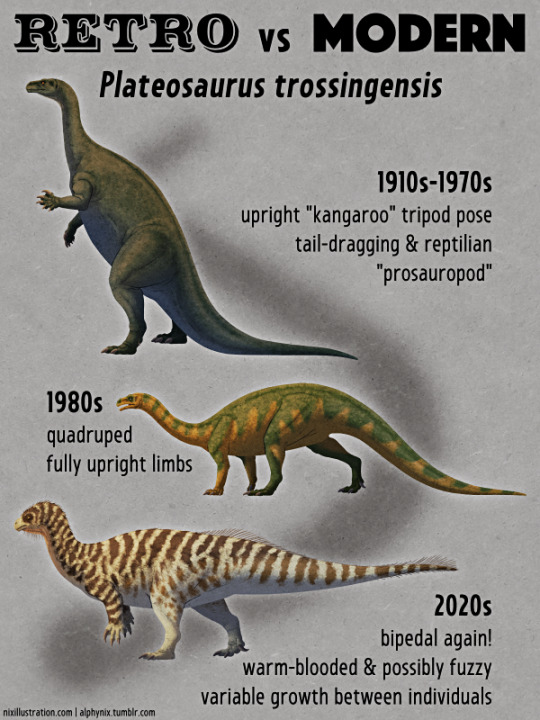
Retro vs Modern #10: Plateosaurus trossingensis
First discovered in southeast Germany in the 1930s, Plateosaurus was only the fifth non-avian dinosaur known to science – but its fossils were fragmentary and poorly understood until the early 20th century, when large bonebeds full of much better specimens began to be excavated.
1910s-1970s
Between the 1910s and 1930s around 80 near-complete skeletons of Plateosaurus were found in two German quarries, quickly making it one of the most abundant and best known dinosaur species of the time. Although it had previously been classified as a theropod dinosaur, in the 1920s the more complete material allowed it to be properly identified as a "prosauropod", an early herbivorous relative of the giant sauropods.
Like many bipedal dinosaurs during this period Plateosaurus was generally interpreted as having an upright kangaroo-like posture with a dragging tail – although some paleontologists were arguing for it having a sprawling quadrupedal lizard-like stance as late as the mid-1930s.
1980s
Unfortunately much of the German fossil material was destroyed during World War II bombing raids, and interest in Plateosaurus didn't pick up again until the time of the Dinosaur Renaissance when a third major fossil site was discovered in Switzerland during the 1970s.
Plateosaurus was reinterpreted with a horizontal body posture and fully upright limbs. As an early member of the sauropodomorph lineage it was often depicted as a transitional form between bipedal ancestral dinosaurs and the later quadrupedal sauropods, thought to primarily walk on all fours but also able to run on its hind legs like a hadrosaur – although some studies instead concluded it was fully quadrupedal with a downwards-curling tail that made bipedal movement impossible.
The large numbers of skeletons found together were considered to represent evidence for herding behavior, with groups of Plateosaurus being caught in catastrophic mudflows all at once.
2020s
Extensive biomechanical studies in the 2000s and early 2010s clarified what sort of posture Plateosaurus was really capable of. It was found to be completely unable to position its arms in a quadrupedal stance, and so was actually purely bipedal – and skeletons that had been mounted in the quadrupedal position had needed many of their joints to be completely dislocated to achieve the pose!
A huge number of different Plateosaurus species had been named over the genus' nearly-200-years of history, too, creating a confusing mess of dubious and invalid names. These were all finally revised in 2019 leaving just three valid species, with Plateosaurus trossingensis as the best known and the new type species.
We now know Plateosaurus lived across central and northern Europe during the Late Triassic, around 214-204 million years ago, at a time when the region had a subtropical climate. It had a small head on a long flexible neck, with teeth convergently resembling those of modern iguanas suggesting it was probably primarily herbivorous (with possible opportunistic omnivory). Its arms were proportionally short for a prosauropod but were well-adapted for grasping, with large claws that may have been used to dig up roots and tear down branches
It had a rapid growth rate and bird-like lungs and air sacs that suggest it was warm-blooded, and different individuals showed an unusually high amount of variation in adult size and age of maturity. Some appear to have been fully grown at about 5m long (~16') and as young as 12 years old, while others reached 10m long (~33'), and were still growing at 27 years old.
The bonebeds are no longer thought to represent mass mortalities of herds, but instead were probably a scenario more similar to the La Brea Tar Pits – mud-miring traps that smaller lighter animals could escape from but larger individuals became stuck and died.
No prosauropod skin impressions have been found yet, so it's still unknown whether Plateosaurus was scaly like later sauropods or if it had some degree of protofeather hair-like fuzz.
———
Nix Illustration | Tumblr | Twitter | Patreon
#retro vs modern 2022#science illustration#paleontology#paleoart#palaeoblr#plateosaurus#plateosauridae#prosauropod#sauropodomorpha#dinosaur#art#retrosaurs#the plentiful posture perils of plateosaurus#what walks on two legs in the morning; four at noon; and two again in the evening?
872 notes
·
View notes
Text
tl;dr my country is literally on fire and the politicians refuse to help
I know there's a lot going on in the world, but you probably haven't heard about what's happening in Australia.
we're on fire.

approximately 1/4 of australia’s population is in catastrophic fire danger. A catastrophic fire level means your only chance of surviving is leaving before it’s too late.

it’s Spring in Australia, and rainforests aren't meant to be dry enough to burn, yet at the time of writing this (11/11/19) there are 71 active fires in NSW (43 out of control), and 51 active fires in Queensland - not including those that have already burned before now, and there are more in other states. Sydney is already rated "catastrophic", the first time this rating has ever been used there since its creation in 2009. That's right, we had to add yet another level of destructiveness, because "high", "very high", "severe", and "extreme" were no longer adequate. To quote the Fire Danger Ratings, "for your survival, leaving early is the only option". conditions tomorrow will be the worst they have been, and people are evacuating as we speak. the fire fighters are preparing as best they can.

This isn’t just about people losing their homes; people have died and will die, countless animals have already lost their lives and many more will still perish. our land, our lives, and our hope is up in flames and will soon be nothing but ash. the annual fire season has not even begun yet. this is only the beginning. my native land is burning, and there is nothing i can do to stop it.

the government refuses to acknowledge that we are in a climate crisis. the fires have never been this bad. we have been in severe drought for more than a year which has only contributed to the force of these fires. the Prime Minister Scott Morrison has done nothing but send his “thoughts and prayers”. He will not accept aid from other countries because he is too egotistical to admit that we need it. All the while the people of this land are suffering. Climate change needs radical human change to be combated. we are already seeing the results of years of indifference, and this is barely the beginning of something that will only get worse the longer government’s and big companies refuse to act to counteract climate change.

Our government has also cut funding to Fire and Rescue NSW by 35.4%, the Rural Fire Service by 75.2%, and QLD Rural Fire Service by 26.42%, resulting in closures of services; they don't have the resources to cope. We are fighting a losing battle against the results of climate change. and this is only the beginning.






12/11/19 UPDATE
At least 6 million people today are prepared for evacuating. There are strong winds, low humidity, and high temperatures which will only exacerbate and encourage the fires. Authorities have warned that there aren’t enough fire trucks to help everyone, so unless you are prepared to the maximum, you need to leave. 600 schools and TAFE’s across NSW have been closed due to the fires, with others in Queensland closing due to air quality being virtually unbreathable due to smoke. Rural Fire Service Deputy Commissioner Rob Rogers said the state was as prepared as it could be, with military aircraft on standby to rescue people from fires if needed. Smoke from these fires have reached as far as New Zealand and New Caledonia.
As Queensland and New South Wales deal with these unprecedented bushfires, there is a lot of talk about how to stop, or at least reduce them. David Bowman is a professor of environmental change biology at the University of Tasmania and he says the short answer is that climate change is making a bad situation worse.
But it’s also much more complex than that. Much of Australia’s natural biodiversity has evolved to withstand and even stop bushfires due to a multitude of species being in one area. Eucalyptus trees encourage fires as they help spread seeds, but other species are naturally flame retardant and help to curb the fires. The issue is that so much of the native bush has been cut down for farming and agriculture that the natural fire defence has virtually been destroyed. Australia is the leading country in mammal extinction, as well as one of the worst 7 for biodiversity loss.
There have already been significant harmful impacts to wildlife, with entire ecosystems up in smoke and individual species affected, including around 350 Koalas presumed dead – all before the fires have reached their peak.
my heart goes out to the victims of the current fires, which we know have been exacerbated by the decline of native biodiversity. Australian conservation efforts need a radical overhaul. Mitigating the intensity of these fires, mostly set by humans and their activities, can be achieved by restoring our native ecosystem engineers, such as bandicoots, bettongs and potoroos.
These species help to maintain healthy forests by continually turning over and breaking down forest leaf litter, thereby drastically reducing fuel load. In their absence, fires are more intense, often reaching the treetops, which can affect populations of species already on the brink, like the Koala.
Slow growing and ancient Australian East coast temperate forests are of global significance, as these forests have some of the highest carbon storage on the planet. Fires of this intensity threaten their very existence but managing wildlife to reduce fire intensity and protect forests is under-appreciated for its importance in reducing the release of carbon into the atmosphere.
If you wish to donate to the NSW Rural Fire Service, follow this link. I’m not sure if it works for countries outside Australia, but if you can spare some money, please try
http://www.rfs.nsw.gov.au/volunteer/support-your-local-brigade
Or you can donate to the Red Cross who have set up many shelters and are providing first aid, and are trying to fund small kits to provide families with basic necessities
https://www.redcross.org.au/campaigns/disaster-relief-and-recovery-bushfires
#climate change#fire#bushfire#catastrophe#natural disaster#man made disaster#australia#climate justice#auspol#climate emergency#please share this#scomo and the libs can all suck my big toe#they care more about coal and oil than they do about the climate and the australian people#please send some good thoughts prayers and vibes to the firefighters tomorrow#theyre really gonna need all the help they can get#the world is burning
89K notes
·
View notes
Text
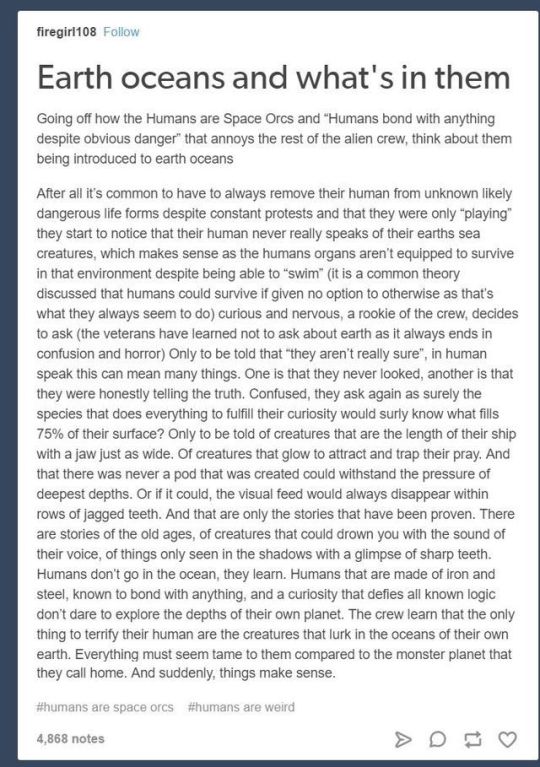
“We’re a well-oiled team of military-grade kindergarteners,” his best friend, and the only other human on the ship who would understand what kindergarten was, continued chastising him and his companions. “The level of education and training among the three of you eclipses that of the entire rest of the members of this operation,” Annabeth continued, pointing her finger individually at himself, his pilot Jason, and his Chief Science Officer Nico. “You know, I’m not that surprised with you, Percy, but you are our XO so you should really be more responsible,” he winced at that, still feeling a bit of imposter syndrome at being the Commander of the USS Olympus. “Jason, shouldn’t you be piloting a ship or something?” At that, he saluted her and did an about face before scampering off to get into more trouble. “And you, you’re definitely way too responsible to have gotten mixed up with this Seaweed Brain and Sparky, so what’s in this tomfoolery for you?”
Nico, the only Neptunian on the ship, shifted his large black wings self consciously under the scrutiny of their Chief of Operations. Percy, as the Commander of the vessel, felt obligated to protect his usually stoic and well-behaved… acquaintance? Di Angelo was reserved, almost standoffish, and resented anyone who tried to stick up for him for some reason, but that didn’t stop Percy’s stupid seaweed brain from doing so. Hence the acquaintance. Percy was 99% sure Di Angelo didn’t consider him a friend. But he was nice to Percy and a great officer, so Percy considered him his friend.
“It was my fault, Annie,” he used her childhood nickname carefully, not knowing whether it would soften her up or piss her off more. He was hoping for softening. “It was just another one of Jason and my dumb ideas that we thought we would need a scientist to help with, and we didn’t want to piss off Leo by involving him in it. You know how he is about his engineer and warp cores and whatnot,” Percy held his hands up placatingly. “Leave Di Angelo out of this, he has sciencey things to do, isn’t that right?” Percy side-eyed his companion who (not surprisingly) rolled his eyes.
“I try not to get involved with human pranks or even Jovian mischief, but Officer Grace and First Officer Jackson were about to be meddling with my linguistics team. It isn’t my duty to tell my superiors what to do, so I sought out the next best option, supervising and ensuring no lasting damage was done to the physical or emotional state of the linguistics team. Now,” Here Percy held in a smirk as Di Angelo shrugged. “If they caused interference with the machinery of the ship, that wouldn’t be my expertise, so I allowed it to happen and-” Percy held back a laugh as the other male started speaking even faster to get everything out as Annabeth turned redder and redder. “I’m very sorry about that, truly, but I had no control over the situation.”
“No control over the situation? You three broke our LIT machine and now we have to go back to Earth as soon as we pass close enough to fix it. Soon enough nobody on this ship will understand each other,” the woman across from them crossed her arms and Percy shrunk back a bit.
“I want to make a joke about a machine being called “LIT,” but I feel like it isn’t the right time,” he muttered. “I know the Linguistic Inhibition Technology is important, but most of us have a working understanding of at least one other language, so it shouldn’t be a huge issue, right?”
“You know it works by connecting to the implant technology in our brains, so as it shuts down one by one, members of this ship from spaces stations and planets far and wide will have no clue why they suddenly can’t understand their XO, or their Chief Officer, or their best friend. So you better explain this. And you have to tell them that we’re going straight back to Earth to fix it because no nearby planets have the same brain implant tech as us. Damn Terrans and their brand name technology copyrights,” Annabeth grumbled and finally turned around to walk off.
“Hey, you’re Terran, too!” Percy shouted after her, but she just flipped him the bird.
“She can do that?” Di Angelo asked, side-eyeing Percy.
“Yeah, she’s been my best friend since we were twelve. As long as she doesn’t undermine my authority in front of everyone else, I don’t really care. I’ve done way worse to her,” Percy laughed at the other man’s frown. “Nothing bad, just pranks and things of that sort. Maybe when we get back to Earth we can show you where we’re from. You never set foot off of the training grounds while you were in school.”
“I would… like that,” Di Angelo paused and gave Percy a soft smile.
“Great,” Percy patted the younger male on the shoulder and made his way to the Command Center.
Percy sat himself down in the rotating chair and pressed on the comms device.
“Gooooood evening crew of the USS Olympus, this is your Commanding Officer, Percy Jackson, speaking,” he smiled at the engineering crew that was scuttling by, only for one of them to pause and look at him like he was speaking a different language… Whoops.
“There was a malfunction with the Linguistic Inhibition Technology and we will be returning to Earth henceforth to repair it before the damage becomes problematic. You may experience glitches with your implant technology and may revert to only understanding your first language and those you have studied extensively. If somebody looks like they’re not understanding what I’m saying right now, please escort them to the linguistics team in Science Bay 3. Carry on. Jackson, out.” He clicked again and the mic turned off.
He sighed, this would be one of his bigger mistakes. They were supposed to be exploring, but they couldn’t do that if nobody could speak to one another. One trip home couldn’t hurt him, and he was sure Annabeth would be happy to see her father.
It wasn’t until later after the Chief Officer meeting when someone finally asked Percy about Earth. For many of the non-humans on the ship, Earth was a place to get education and training to go out in the star fleet, and they never set foot outside the campus grounds, just like Di Angelo. But people had stopped asking him questions because Earth was basically “Space Australia,” as Annabeth had explained to him. The adaptability of humans and their need to pack bond astounded many and horrified many others. So, he stopped talking about home.
It was a new member of their ship, Novax (a Vulcan who was a part of Leo’s engineering team), who asked him about it first.
“I hear Earth is 75% made of pure salt water, and is filled with animals of all kinds. Do you have a favorite water animal?” he asked Percy excitedly.
“Definitely dolphins, though they aren’t underwater creatures. Like humans they need oxygen to breathe, and come up for air very often. My favorite actual underwater species would have to be a hippocampus from Neptune. I’ve always wanted to go and see one, but my human anatomy prevents me from going on-planet,” Percy explained and sipped on his hot tea.
“There are a million creatures in the ocean and you pick one that doesn’t breathe underwater?” Clarisse grunted. His Chief Tactical Officer was a brutish Martian, but very specialized in weapons. “And your second favorite isn’t even Terran.”
“What else do you know about the ‘ocean’?” Novax breathed, leaning forward.
“Eh, not much,” Percy shrugged.
“I’m not sure I heard that correctly, maybe my LIT unit isn’t functioning well,” another member of engineering asked, Nyssa. “Your planet is 75% water and you don’t even know what is inside it?”
“I could tell you about the people who spend their life learning about what survives in the deep depths,” Percy looked up, knowing he had all of the non-Terrans hooked on every word. Even Di Angelo had paused in his note taking and was staring wide-eyed at Percy. “But I don’t know if you’d want to know.”
“No we do!” Nyssa exclaimed. “There are people who dedicate their lives to a place that’s literally not navigable by humans, the main inhabitants of the planet?”
“Well as you said, most of the planet is water. Which means that coastal communities are filled with fisherman, whalers, swimmers, and more. I could tell you about some of those. I could also tell you about the scientists that spend years of their lives building bots that can’t even come close to withstanding the pressure at the deepest depths without imploding, or I could tell you about those that do come close,” he shrugged.
“What happened to those?”
“The video feed cut out after only seeing multiple rows of sharp, jagged teeth,” Annabeth answered, her sharp grin frightening those who hadn’t noticed her. Some forgot that she was Terran, because she was also half Minervan.
“I could tell you about whales. Beautiful, they come in black and white or grey or blue. But they can be as big as almost 100 feet long. That’s as long as most pirate ships. And they could fit about 400 average sized humans in their mouths. You don’t want to cross one of them. And they only live on the surface. The things that live in the deep,” Percy shuddered for effect. There were no Neptunians on the ship, so there were no natural water dwellers there, so all of his rapt listeners were shocked by this information. “There’s the anglerfish. They light up the dark with an antenna on top of their heads, and the light lures in prey. But it’s so dim elsewhere that you don’t see their big sharp teeth until you’re right up against them,” he murmured. “Giant squids are almost as big as whales but not nearly as peaceful and beautiful. They have eight arms and two tentacles that could wrap around any boat and crush it.”
“Ten limbs?” Nyssa whispered, clearly disturbed.
“Plus, the Portuguese Man o’ War,” Percy shrugged nonchalantly. “Also known as the floating terror. It’s like a big blue jellyfish that sits innocently on top of the water with huge blue tentacles that sit just underneath with a sting strong enough to kill a full grown human.”
“Don’t worry,” Annabeth grinned that shark grin again. “Percy won’t tell you about the stories of the old days. He doesn’t want to scare you.”
“That was the not scary part?” Novax gulped.
“Anyway, I just got notified that we’ll be back on Earth in a few days, so brace yourselves,” and with that, she stood and left them all staring after her. When the door clicked shut, Percy had all eyes back on him. He shrugged.
“Don’t look at me. I wasn’t going to tell you about the kr- nevermind,” he stood. “Di Angelo, with me,” the younger officer stood, back to business and was at Percy’s side again in a moment. “Clear your schedule, you’re spending shore leave with me, pal.”
“Great,” came the deadpan reply.
“Don’t sound so somber,” Percy rolled his eyes. “I’m just going to show you the beach and maybe a good gay bar. You need to let off some steam my dude.”
The other male reddened.
“That is so… That is…” he huffed. “Highly inappropriate.” he glared down at the ground and Percy felt a little bad, maybe the guy wasn’t out? But it was clear he had a preference for males. Oh well, that foot was already in Percy’s mouth.
“Fine. But I will be attending and I am a great dancer so you’re missing out,” he winked at the flustered officer and made his way back to his cabin. It would be an interesting few days.
He made a plan with Annabeth. Day one before shore leave, Percy would spread a rumor to Novax about the kraken. Bigger than a giant squid and meaner. Known to crush entire pirate ships in the olden days.
Day two, Annabeth would mention sirens to Nyssa. Hideous creatures that could lure you in with their voices and lead you to believe you were bringing your ship in to everything you ever wanted, when in reality you would crash your ships and then drown.
Day three, Percy would tell Leo about the Megalodon. A definitely very real shark so big you couldn’t even imagine it. Percy shuddered at that one.
“But, there are some good things,” Percy was speaking to Nico Di Angelo from his Commander chair, in ear shot of some of the participants of the conversation a few nights prior. “Mermaids, the siren’s nicer cousin species. And the lost city of Atlantis. Known to be a great and bountiful city, lost to the sea and cursed by the gods to be stuck down there forever. Some believe it still exists, but it’s within the Bermuda Triangle.”
“What, pray tell, is the Bermuda Triangle,” Clarisse sighed.
“Hard to explain. Ships just… go in… and they never come out,” Annabeth shrugged. “Planes go down. Ships wreck. People who go in don’t come back out, so we don’t know if Atlantis is really there or not.”
“That’s… terrifying,” Novax whispered as he walked by.
Percy was sure he had created a healthy fear of Earth’s oceans in his crew. And he meant to, because while he loved the beach and swimming, he did want to make them shy away from the depths. They wouldn’t do well to explore it.
#percy jackson#humans are weird#humans are space orcs#star trek#fusion#nicercy#percico#if you squint
186 notes
·
View notes
Text
Sentient species that are food in Star Wars
In the galaxy far far away food is like in most sci fi properties:
- some colorful fruits and vegetables
- soups and blobs with unrecognizable ingredients, sometimes disgusting and played for laughs
- regular food, like bread or milk
- regular food/dish but written/pronounced in a different way etc. (sandwich called sliders)
- regular food/dish but made of different ingredients/from a different animal, like bantha butter etc.

What's most unique about star wars is that it addresses that different species might mistake/see other species as a potential lunch.
Unlike our definition of cannibalism, which is also mentioned in star wars, one would be considered a cannibal not only for eating someone of their own kind, but also other sentient being.
You are not a cannibal because you ate a steak from a cow, despite what some vegetarians might say.
But what if someday we meet an alien species that looks like cows ? Obviously we wouldn't eat them, but if they saw themselves in creatures that we eat that would make future interactions awkward for both of us.
Now I'm going to list every instance of cannibalism (both types) in star wars that I know of. Also I'll try to guess which species eats others the most and which gets eaten the most. Feel free to add more if I missed any.
1. Bossk had cannibalistic tendencies. He ate his siblings before they hatched and later his father when he defeated him. He also likes to eat Zanibar and Wookiees. It's not really clear whether it's a norm for his kind or just Bossk being a ruthless killer. It's well established in legends and cannon that Trandoshans hunt sentient being for trophies, not so much for food. They also have a costume of eating their shed skin after a long post. Trandoshan liver is also apparently a delicacy for some people. Unless it's just a sick joke.
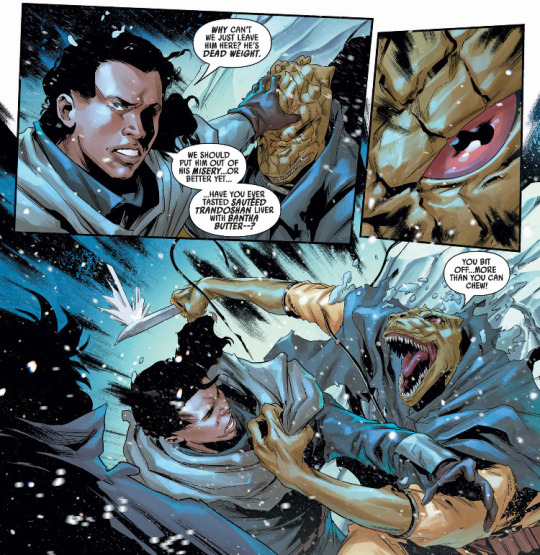
Those lizard are very versatile, they eat others, each other, themselves and can be eaten.
2. Previously mentioned Zanibar, their religion demanded frequent sacrifice of sentients. It was believed that the rituals involved a feast of their enemies' bodies to give their life forces as a sacrifice to their gods. Maybe it's better for everybody that they are one of Bossk's favorite miles.
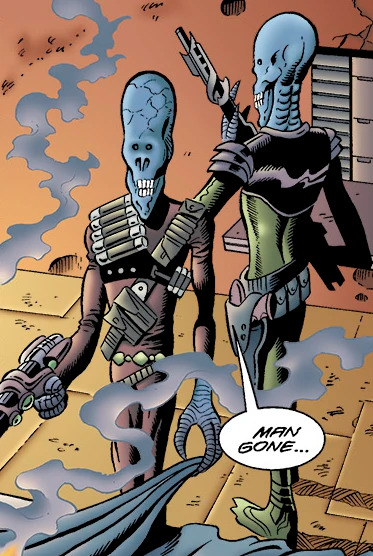
3. Certain Hutts were known to eat their enemies. They are also fond of a drink made off Rodians. Maybe that's why Jabba got so many Rodian bounty hunters, if they died or failed him, he could just eat them.
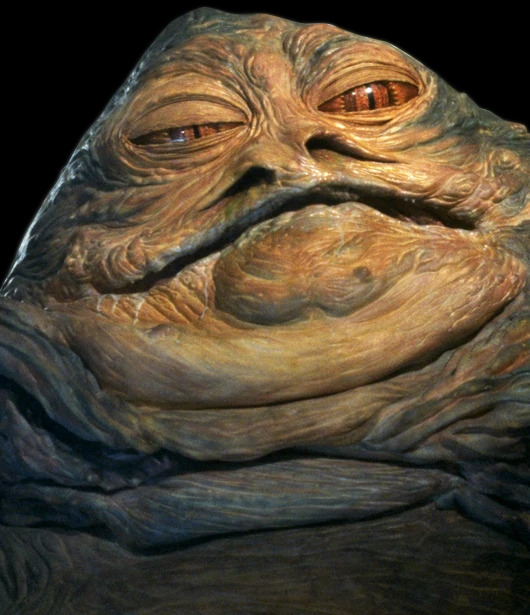
4. Humans aren't much better. Dezono Qua who lived during the rise of the Galactic Empire, was a known cannibal; he purchased slaves at market and had his droid cook them. Resa Greenbark, a Nosaurian, was one of the unfortunate slaves bought for food. "She was something…special."- Dezono Qua
Certain Human cannibals were known to roam throughout the cities and wilderness of the planet Tatooine. Where else, am I right ?
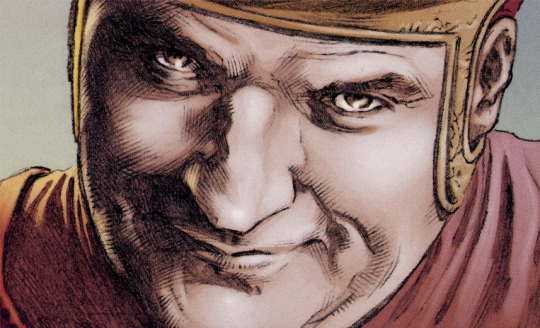
5. The insectoid Colicoids were known cannibals, eating off-worlders who landed on their homeworld and sometimes capturing vessels which passed too close.

6. The Rakatan individual known as The One forced many species to revert to this practice.
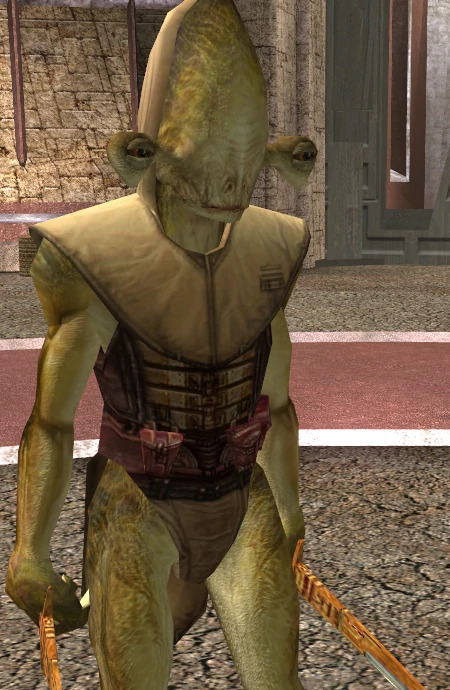
7. Karkarodon are known for ripping apart their enemies with their teeth. They can also go on a feeding frenzy on sentient beings when hungry or in rage. Riff Tamson munched on Mon Calamari, Gungans, Quareen and Clone Troopers aka Mandalorians aka Humans.

8. Ewoks considered humanoid flesh a delicacy, they prepare fires in anticipation of eating Han, Luke and Chewbacca to absorb their power. They were about to eat some Stormtroopers/Humans but Leia and Han stopped them and gave them ration sticks instead. At least one member of the species wanted to eat a Nautolan and a Rodian.

9. Chewbacca, a Wookiee, was fed Han Solo, a human. Of course he didn't eat Han, but how long was he there and what was he eating till their meeting.

10. The reptilian Marits were traditionally cannibals, as well, though the Marits' only ate those who had already died, and did so as a means of disposing of the bodies in a way they deemed beneficial to the living.
I would say that Trandoshans and Hutts are the ones that eat other species the most. Going by how common both species are, how much Hutts eat and Trandoshans hunt.
The ones getting eaten the most are Humans and Rodians, because they are one of the most common species, are rather easy to kill and come up multiple times in my research.
#star wars#star wars the clone wars#star wars rebels#star wars aliens#star wars species#Bossk#Trandoshan#Dezono Qua#Ewoks#leia organa#han solo#sci fi books#sci fi#chewbacca
56 notes
·
View notes
Note
You go on about how intelligent/emotional pigeons are, but you treat them like objects and that bothers me. You separate bonded pairs of these intelligent, loving animals so frequently as if they don't have any feelings. And then you wonder why these birds afterward do not just take a new mate instantly. You are continually traumatizing these animals and causing them to shut down because they probably begin to realize any new bond they make will only be severed.
I do that because they are.
There is a huge difference between treating a living being like an object and acknowledging that the feelings of a non-human will not often perfectly align with those of a human.
Different species are different.
They have different physical, emotional, and social needs, even if there are a lot of close parallels.
And there are certainly a lot of parallels between humans and pigeons;
They are self aware cooperative social learners.
They form societies.
Those societies have a culture that varies regionally and they have a base line of values...
But their society, culture, and values are different from a human’s because pigeons are not human.
Nothing specializes in preying on humans. We generalize in preying on everything, as a species, as a whole.
We change our environment to suit our needs as much as we are able, and we are more able with every generation.
While things, objectively, can happen to any human at any time, out of nowhere..
On the whole, we generally don’t expect them to.
As such, our monogamous relationships are, ideally, “Until death do us part” meaning “Until we both die of old age, preferably around the same time.”
To the extent that closely bonded humans are emotionally devastated by the loss of that life partner.
To many of us, a life partner is also counted as lost if they engage in sexual infidelity, and if this happens, we are just as devastated (if not even more devastated) as we could have been if that partner had died.
Pigeons are a prey species that evolved in a cheetah-and-thompson’s-gazelle-style arms race with the Peregrine Falcon.
Their monogamous relationships version of “Until Death do us part” can be better translated; “Until one or the other of us gets eaten on a foraging trip.”
And sexual fidelity does not enter into the equation for a pigeon unless their partner is treading or being tread by some one else at the exact moment that bird wants to tread or be tread by their partner.
A cock who wants sex will seek out his wife first, but if she is not interested, he will go asking all the hens away from their nest until one agrees and crouches for him.
If his mate changes her mind and wants him to tread her, she will seek him out and crouch to present herself.
He will tread his wife, and after they do the cute little “I just had sex” dance that’s reserved for mated pairs (side flings get neither this nor courtship. Just sex and separate.) she goes off to do what ever she wanted to do.
If the cock is satisfied, he goes with his wife.
If he still needs or wants more sex, he can tread as many hens as he wants. His wife will not care, because she has had her turn.
If a hen wants sex, she will seek out her husband, generally, but if he’s busy or away, she’ll present for who ever she likes.
Her husband does not care who filled the egg. He only cares that she lays it in his nest and he gets to help set and raise it.
Pigeons divorce partners they consider to be inadequate. Cocks who fail to fill eggs, hens who refuse to set eggs, partners of either sex that don’t spend enough time reaffirming their bond with their spouses...
Unrequited relationships and love triangles are also relationships that pigeons find themselves in.
A pair is considered to have divorced if one partner or the other moves in and spends their nights in the nest of another partner, not for mating with some one else.
Some times, divorces are mutual, and both birds move on to other mates.
Some times, they are not. And the partner left will pine and keep making overtures to reconcile with the partner that left them.
But when a mate just disappears and doesn’t come back, they are assumed by the remaining partner to have been eaten.
If they were closely bonded, the remaining partner may wait a week or so at most, in case they were lost, in hopes the missing bird will make their way back and reunite.
If, after a week, the remaining bird is keeping to them self and not socializing, something is physically wrong, and anthropomorphizing it as “depressed” can get the bird killed.
The veterinary term ‘depression’ describes an animal that is physically ill, be that from a pathogen attacking it to ingesting or absorbing a toxin or simple vitamin or mineral deficiency.
For example;
A week after I became aware that breeding pigeons could become salt deficient and gave the flock a salt and trace mineral brick, birds that had shown no interest in bonding or courting for months are suddenly flirting with everything that moves.
They were not too traumatized to before.
They had a mineral deficiency.
They did not court because they did not feel good.
With the addition of their supplement brick, lo and behold, they all feel better and are courting again.
I have an entire flock to take care of, and I am responsible for the wellbeing of every individual I bring into the world.
To avoid overcrowding, I have a cap of 10 breeding pair.
Because that is the number of adults and their offspring under 6 months old that my loft can comfortably house.
When ever a new breeding bird leaves quarantine or a keeper reaches 6 months, a bird of the same sex has to be retired and made available to avoid overcrowding and the stress and disease that come with it.
Who retires when is not arbitrary.
There are very strict criteria.
1. Physical health.
Regardless of whether or not I have a replacement ready, a bird who may be hurt by the physical process of reproduction or the strain of rearing young, or who may pass on genes that may be harmful to potential offspring is retired on the spot and adopted out with a strict nonbreeding agreement.

Gus is a sweet boy,
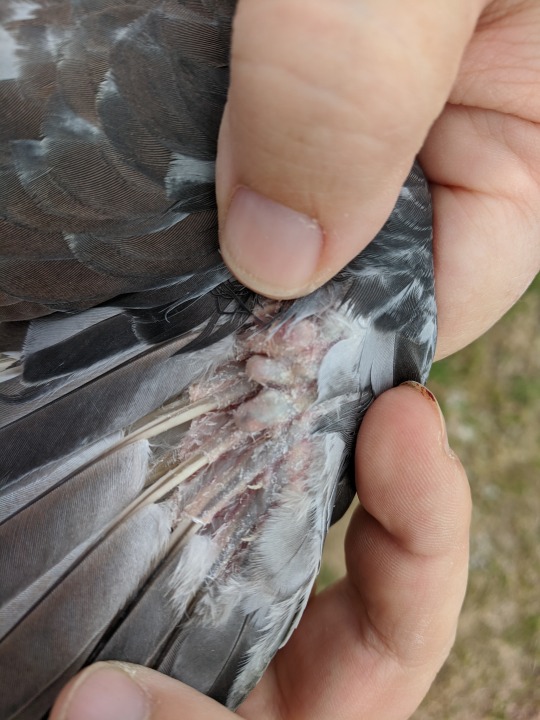
But this happens to him every molt, and we have since found out that it runs in both sides of his family, proving it to be genetic and cumulative.
As cute as he and Leela were together, I cannot let him breed.
Because I would have to be a monster to be willing to knowingly pass that painful condition on to another generation.
He has a forever family familiar with his condition to whom he is going on Monday.
2. Undesirable structure
I do not mean anything as stupid as “This animal isn’t pretty enough.”

Cody is not only gorgeous, but an excellent father who has served our program very well.
But his muffs are big enough to make walking uncomfortable, so while I like the rest of his traits, that’s one I want to breed away from.
Now that I have a brother and Sister of his with short muffs that do not cause them discomfort,
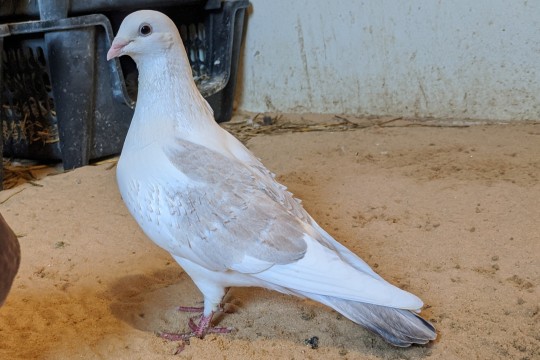
Farthing

and suki
will continue contributions to the project
and Cody is available.
3. Antisocial behavior that disrupts or disturbs their flock mates.

Indica

And Pookie
Are the poster children for flock disruption.
They are a gay and bi mated pair of cocks, who are literally turned on by prying other treading pairs off of each other.
If they see another pair treading, Indica will grab the hen by the scruff, Pookie will grab the cock by his, and they will pull in opposite directions, prying the treading pair apart, and marching them in opposite directions towards the wall.
Indica and Pookie will then throw the bird they have at the wall and then run back to meet each other in the center of the floor, smooch-feed each other back and forth, and take turns treading each other.
On top of this, they defend 15 of the 36 total nest boxes in my loft, refusing to pick a specific one or let any other pair settle in a box to lay.
You may or may not have noticed that when I advertised the available birds on Thursday, I made a point of saying that I would prefer these two be adopted together because they are bonded and would be happier that way.
A prospective new family is coming to meet them on Monday.
But they are SUCH a violent disruption to their flock mates that if only one had a home lined up, it would be unkind to the rest of the flock to keep them both on the insistence that they go together.
4. Shitty parenting history
Parents who tend to ignore eggs or peeps, leaving all the work of setting or feeding to their partner.
This is a personality trait, and such a parent puts dangerous strain on their partner and stress on their peeps.
Their partner will usually divorce them for that, so adopting the bad parent out isn’t “Splitting up a bonded pair”.
Their former spouse is usually looking for or has found some one else with out any interference on my part.
5. Too many offspring/grandchildren
This is to avoid any more inbreeding than necessary.
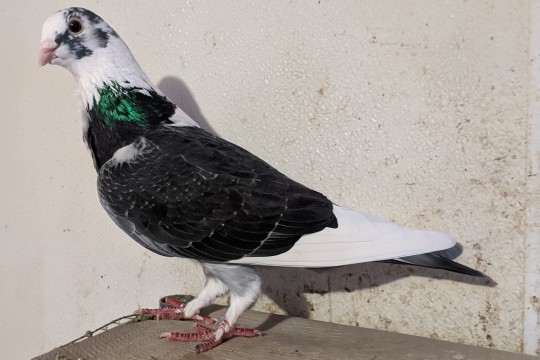
Betty is one of the best studs here.
He is an outstanding father who sits tight on his eggs, pumps his peeps full, and educates them carefully though weaning.
MANY are his children and grand children, and he has a strong preference for birds with faces like his.
He has already bred with his niece to produce Sherry, and I would like to avoid having him breed to any more of his kin.
Once his peep with Liang is weaned, he will be adopted.
Liang is very skittish, and she liked him right off the bat, so I delayed his retirement to give her more time to feel secure with the flock.
But with her egg hatching, she is allowing herself to be casually flirt with more.
Wukong still likes her. So do Cherub and Ginger, so she’ll have her pick when Betty goes to his new home.
6. Temperament
The Therapy Bird Project is working towards developing a performance breed with a temperament conducive to Therapy work.
All else being equal; The birds are all physically sound with no known detrimental genes, no embellishments too exaggerated, not overly aggressive to flock mates, great parents... Then the bird least interested in human company gets retired.
The ground work of physical and mental base soundness has to be laid first and foremost for that excellent temperament I’m aiming for to shine in their handler’s lives for as long as possible.
You probably have not noticed that when bonded pairs retire at the same time, I make a thing of them being bonded in hopes that they will be adopted together.
Dodger and Alex retired close enough to each other that both are still here, and I would prefer they be adopted together.
But if one of them gets a perfect home lined up where I think that individual will be happy, I will not refuse them that good home for the sake of not splitting up a pair.
You care about the idea of that a LOT more than the pigeons themselves do.
259 notes
·
View notes
Text
I feel like there’s a certain amount of weirdness related to having a hearthome that’s got a questionably sentient planetary-consciousness-slash-deity inherently ingrained in the nature of the world, and also like I don’t think or talk about my hearthome enough, so here’s some thoughts.
For those of you who don’t know, I have a hearthome in Pandora, from Avatar (2009) - a hearthome being essentially a place (fictional or real) that feels “like home”, feels familiar, feels deeply right to you, despite you never having actually lived or spent a significant amount of time there. I have no real explanation as to why my brain latched onto Pandora so much - it’s not like Avatar was an especially formative media for me compared to a bunch of other things that had way bigger impacts on my life, but for some reason Pandora just... hits right, I guess, for lack of a better term. Maybe I lived a life or lives there, maybe it’s entirely psychological, maybe it’s an explanation I haven’t thought of yet, who knows.
Regardless, as I opened this with, there’s a certain amount of weirdness associated with this particular hearthome, largely because of Eywa. For those of you not familiar with Avatar lore, Eywa can be described many ways - she’s probably most often described as the deity of the Na’vi, the native sentient species of Pandora, but personally I feel like that’s really not doing her justice. Eywa is a result of a feature of Pandoran wildlife, wherein the plants and animals of Pandora almost universally (as far as we’ve seen) share the ability to connect and communicate directly between neurological systems (or the equivalent thereof in plants) - in the movie, Grace describes the constant connections between the trees as “like the synapses between neurons.” Eywa is the result of that constant communication - the collective consciousness of every lifeform on Pandora, both those currently living and, as we see at the Tree of Souls and the Tree of Voices, those who have since died but who were once connected to the network.
“She,” at least in my interpretation of the information we get in canon, is not an individual being, at least not in any way we could understand. “Eywa” is a compilation of memories, experiences, thoughts, and feelings from billions if not trillions of beings who’ve lived and died on Pandora, and while “she” shows the ability to listen to, understand, and react to communication via the Tree of Souls in the movie, I don’t think she’s an individual consciousness comparable to us. For me, she’s more comparable to the Force in Star Wars - something that connects and binds everything, that is present in every living being and which both enables life to thrive and continues existing as a result of that life. Not quite a person, per se, but not quite a non-person either - not quite a sentient being, but definitely at least partially sentient and possessing a will of its own.
So with that as background, it perhaps becomes a little more obvious why it took me so long to figure out what exactly my relationship to Pandora is. When I look at pictures or video of Pandora, I feel a longing not dissimilar to my longing for flight and sky, so similar in fact that I questioned for a long time whether I might not just have a kintype from Pandora. But no specific animal resonates with me more than any other, really, including the Na’vi - the ikran feel parallel to dragon, of course, but I’m definitely not an ikran. That, of course, makes a certain amount of sense with the presence of the network and of Eywa; all things on Pandora are connected to all other things, and anything that connects to the network has the potential to briefly experience what it’s like to live another life in another body, perhaps even in another time. (And then there’s the Na’vi, at least, who make direct tsaheylu with multiple animals over the course of their lives and feel what it is to be them even more directly.) And anything of Pandora that dies leaves behind a remnant in Eywa, connected to the whole - perhaps a soul, perhaps simply a snapshot from the last time they connected directly to the network, but either way integrated with every other being that has become one with Eywa.
One could, in fact, argue that to have a hearthome in Pandora is to have a hearttype in Eywa - at least, one could probably argue that for me. But hearthome gets across the feeling easier, I feel like, especially since it feels a bit... arrogant? to claim to understand what it is to be a pantheistic deity like that.
Regardless of semantics, the second part to why Eywa makes having a hearthome relationship with Pandora interesting for me is that it means my hearthome is more tied to my feelings about spirituality than my draconity is, somehow. While I don’t... really believe in pantheism or something similar to the Force, at least not right now, the idea of the Force has always been comforting to me - that there’s something connecting and binding everything, that, to quote a line from the Minecraft end poem that’s always stuck with me, we are not separate from every other thing. Eywa connects to that for me - the idea of living on a world where it’s so tangibly clear that all things are connected and all things are one is comforting, when that belief can only ever be ineffable for us. Being able to touch another’s mind directly, to make tsaheylu with the network and touch the memories and souls of those who’ve gone before, see the shadows of eternity stretching toward the horizon far vaster than one mind could ever comprehend, know that you are not and never will be alone or isolated - it’s something I want to believe in, even if I don’t know that I do believe something similar is true on this world.
And maybe that’s ultimately part of why I connect to Pandora so strongly - it represents something that a part of me desperately wants to have, but that I don’t really feel I can have in this life, at least not in such a tangible, undoubtable way. (Which, of course, begs the question where that want came from, given that it’s not like I’ve ever been particularly wanting for social connection, and probably opens up the chicken-or-the-egg question - do I connect to Pandora because I have a longing for that sense of connection, or do I long for that sense of connection because I have a connection to a world where it’s the norm? There’s no real way to answer that definitively, unfortunately, at least not one that I’ve found.) Pandora doesn’t feel like just a physical home to me, a landscape and creatures that feel familiar and Right - it’s the spiritual aspect of it that calls to me too. I don’t know how common that is for those with hearthomes, but it’s there for me, and maybe it’s part of the reason why I connected so strongly with Pandora compared to all the other fictional worlds that have impacted me.
Anyway. That’s my thoughts. Thanks for reading; have some screenshots of Pandora that I love, in no particular order.




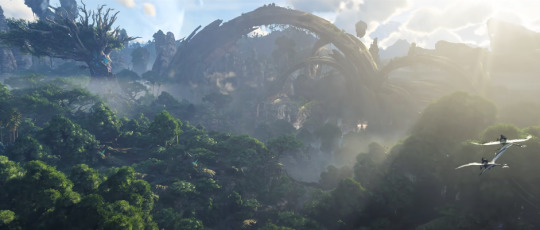
(re: that last screenshot, yes, I am losing my mind waiting for Frontiers of Pandora, nobody’s gonna see me for an entire week after that game comes out if it’s half as open-world as I’m hoping)
#rani talks#hearthome#alterhuman#otherhearted#sort of#do we group hearthomes together with hearttypes? idk#journaling#i have several of these screenshots as zoom backgrounds
52 notes
·
View notes
Text
world building cause twn doesn't part 8: nonhumans
this is easily the geekiest part of the series. and it's a Very geeky series. because sapkowski's worldbuilding is waaay more extensive than i have the time, ability, or desire to convey, i'm sticking with races both sentient and important
colour code cause i fucking love colour codes - already happened/introduced, probably s2, important background info, stuff that might be in the prequel, extras
series masterpost
dopplers
dopplers, also known as vexlings, shifters, mimics, doubles, imitators, or pavrats, are a nonhuman race that can take on the appearance of nearly anyone they encounter
before mass migrations of humans, dopplers primarily inhabited the forests and plateaus around the city of novigrad, where they would transform into wolves and pack animals to hunt
their abilities are pretty impressive, dopplers can not only mimic appearance but also voice, personality, skills, behaviours, and knowledge. dopplers can even turn parts of their bodies into pieces of clothing or other objects
however, there are some limitations
dopplers can't transform into someone/thing with dramatically more mass than they have, are burned by silver, and can't drop anything they created (if they did it would kind of turn into a fleshy goop)
we've already met a doppler in twn, this sexy sexy man
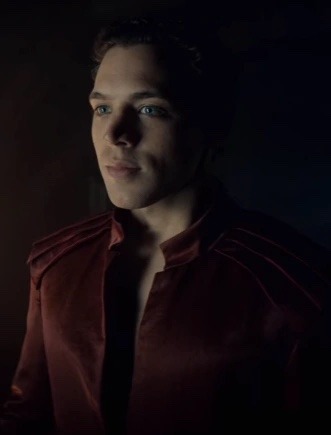
BUT
it is important to note that this doppler is a huge deviation from sapkowski's lore. dopplers are pretty much always exceptionally kind and gentle. a lot of times they use their abilities to appear threatening (big teeth, sharp claws etc) because they really don't want to hurt anyone.
when dopplers aren't mimicking another form, they aren't exactly pretty. they're bald, short, have beady yellow eyes, and kinda look like they're made from soft clay
here's the hexer doppler
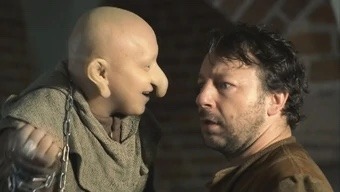
the most notable doppler is dudu biberveldt, who i mentioned as the halfling dainty biberveldt's fake cousin. dudu's actual name is tellico lunngrevink letorte, but dainty decided to help dudu live in novigrad by adopting him as his fake cousin.
dragons
dragons are fucking awesome. you know it, i know it, and zerrikanians know it. witcher dragons are especially awesome
they are the only being, other than cats, that can naturally harness and absorb the force of chaos
there are multiple subtypes, but most dragons fall into one of four: black dragons, green dragons, red dragons, and white dragons.
black dragons are the largest, and primarily live in swamps and wetlands where they bathe in mud. they have extremely hard scales and don't breathe fire, but an acid that causes burns similar to those from mustard gas.
green dragons (right there) are the most prominent yet smallest species of dragon, mainly living in forested areas and breathe highly flammable chlorine gas.

red dragons mainly live in hills and mountain caves and can breathe fire hot enough to melt metal
white dragons are one of the rarest species and live in the far north, and can breathe frost
however, if you watched the witcher netflix as i assume you did, you may remember golden dragons. these dragons are so rare and exceptional that they are not usually included with other species. they breathe steam and fire and can shapeshift into any living being
all dragons communicate through telepathy, although golden dragons can speak when they are in the form of a species that can speak
humans are pretty divided on the topic of dragons, with zerrikanians worshiping them and nordlings hating them.
because they are incredibly intelligent and emotional, witchers (generally) refuse to hunt them
borkh three jackdaws, also known as villentrenmerth, is the only golden dragon we know. there he is right there.
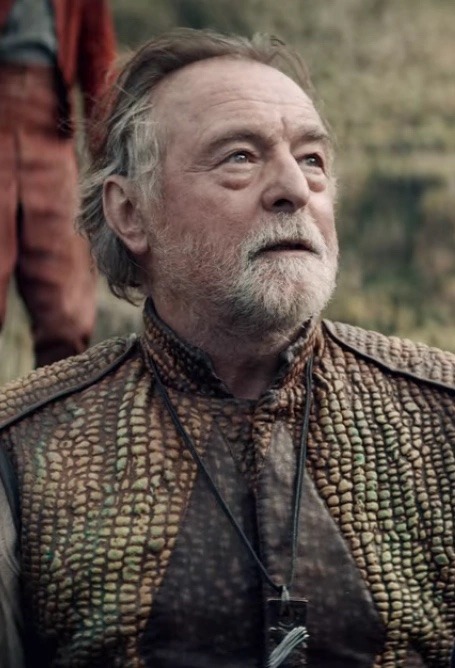
ASSASSINS OF KINGS SPOILERS NEXT TWO BULLET POINTS
the other dragon from twn was a green dragon named myrgtabrakke, borkh's mate. their daughter is named saesenthessis, also known as saskia the dragonslayer (an alias she took to explain her extensive knowledge of dragons) and the virgin of aedirn
because saskia is part golden dragon, she can shapeshift, although is much more limited than her father. she can basically only be a human looking woman with blonde hair or a huge dragon.
cut because this part is getting REALLY long
godlings
ah godlings. i love them so much. they're adorable and precious. they usually look somewhat like a human child, but with blue skin and large amber or green eyes. they don't wear much clothes, their focus is in accessories like jewelry, flowers, or tattoos
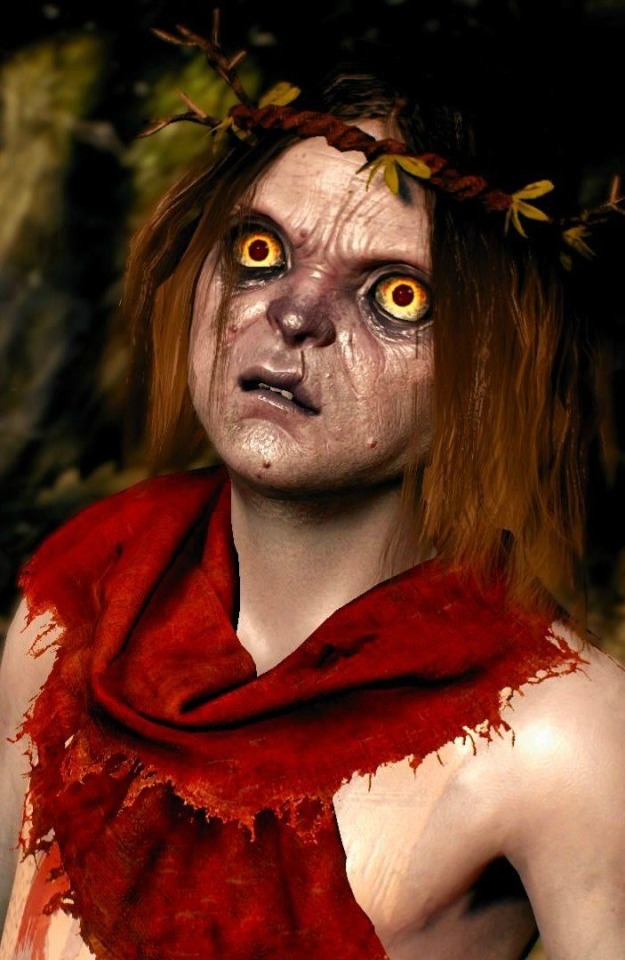
that's johnny, a holding in wild hunt.
godlings are incredibly rare, and are easily confused with young goblins. they primarily live in swamps near drowners, but aren't afraid of them.
they're quite mischievous but kind hearted, many have happy go lucky personalities and love just having fun. i adore godlings. i've said it once and i'll say it again.
higher vampires
definitely the most important group on this list, higher vampires are incredibly powerful and intelligent. they can shapeshift within certain limits, generally either looking like a human or a large terrifying bat. they also have some telepathic abilities - they can basically make you fall asleep and forget stuff
scary wooo
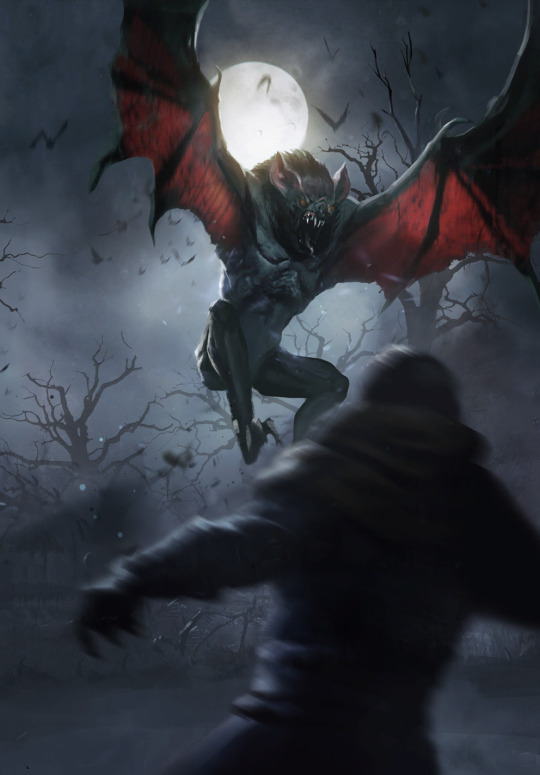
higher vampires do not need to drink blood to survive. some don't drink blood at all. when they do, it's like a human drinking alcohol. on full moons, groups of higher vampires go out partying and get white girl wasted
although all higher vampires have the same basic abilities, each individual has one skill they are exceptional in.
most find humans harmless but annoying, like mosquitos. they don't really like interacting with humans, which works out pretty well as higher vampires can blend in very well, even a witcher's medallion can't detect one
higher vampires also have three distinct cultures, the tdet in the far east, the ammurun across the great sea, and the gharasham in the northern realms
they are really really hard (or impossible, depending on canon) to kill. based on the books, you basically need to disintegrate them. based on the games, only higher vampires can kill other higher vampires, but humans can get close
we only meet one in the books, emiel regis rohellec terzieff-godefroy. he goes by regis for short. regis was an "alcoholic" in his youth, and has since abstained from blood or any other substance. he's incredibly old, by the end of twn season 1 he'd be 425 years old. as for regis' "special ability", he's just kind. he's an incredibly gentle and loving person. that's it. i love him.
merpeople
probably one you're already familiar with! merpeople are intelligent humanoids that inhabit the great sea. mermaids are notably gorgeous, having green hair and tails, and their scales are prized alchemy ingredients
sapkowski's mermaids can breathe above water, but the sun burns their skin so they don't stay at the surface for very long.
merpeople are incredibly powerful, they can summon krakens and the sea-dragon like race of vodyanoy respect their authority
they use their own language that's quite similar to hen llinge, but more lyrical sounding.
nymphs
nymphs are a humanoid race primarily based around nature. they have 5 subspecies, dryads (including hamadryads), leimoniad, naiad, nereid, and oread.
dryads, called eerie wives by humans and aen woedbeanna by elves, are the most prevalent, primarily living in the brokilon forest. some have human skin with olive undertones, but others are green. they usually have dark brown or green hair which is usually worn in dreadlocks (breaking my promise of not being overtly and annoyingly political in this series yet again - the dryads, especially in the netflix adaptation, are classic magical n*gress stereotypes. but more on that later.)
this is a lore-accurate one that i LOVE
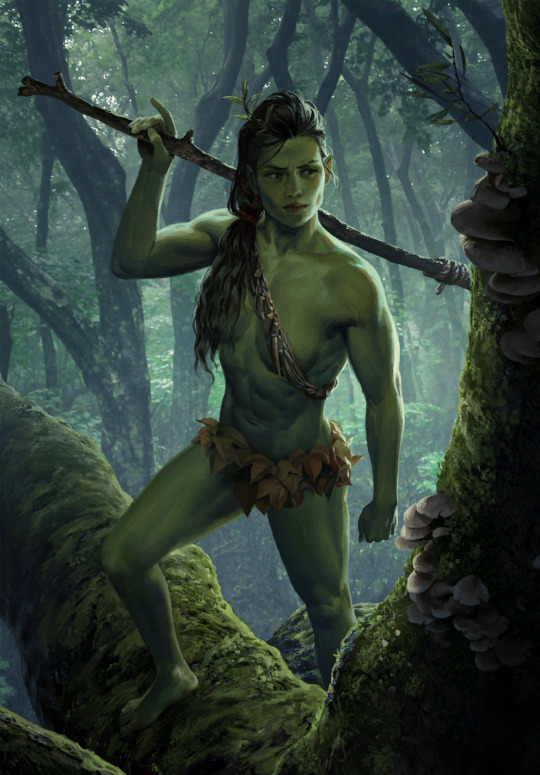
dryads have incredibly strong connections with nature and magic, although it is really rare for a dryad to be a source. dryads are able to draw energy from trees, but rarely do because they don't want to hurt the trees. support dryads and take the bus.
all dryads are women. all of them. they make babies by basically luring men into the forest and doing the adult hokey pokey. also why dryads aren't really a fan of witchers, who don't make the baby butter (i am so sorry)
however, dryads can also turn a girl of another race into one of their own through the use of magic. the water of brokilon has some mutating quality that makes young girls forget their human past and physically turn into dryads, although it is less effective as the girls are older. the dryads tried to do this to ciri, but given that she's a source, nothing happened. generally, this process is done to girls who wander into brokilon, but some dryads will abduct peasants from outside the forest if they need more dryads.
here's twn dryads... yikes

this is where i think the whole racism thing becomes a bit too obvious. "uncivilized" women who live in the forest and have dreadlocks and abduct young girls from "civilized" areas?? in twn they leaned even further into this, having one of the two black women they cast be a dryad and replacing the usual bows and arrows with spears, a less sophisticated weapon. again, this series is about the lore, not the political implications of it, but it is important to keep in mind
dryads are excellent at archery, shooting anyone who comes within 80 metres of the forest. through their connection with nature, they have highly advanced medicine and use glowing fungi as a source of light.
hamadryads are a specific type of dryad that is incredibly connected with her tree. because of this connection they have exceptionally strong magical and healing capabilities, but will also go insane and die if their tree dies.
like merpeople, dryads use a more melodic dialect of hen llinge
leimoniads are a type of nymph that lived exclusively in meadows, but are practically extinct due to wars with humans
naiads, also called rusalki, are nymphs that live in lakes and rivers, although a few live with the dryads in brokilon. naiads are very similar to dryads, although they tend to have very light skin with very dark hair, webbed hands, and can dry out on land
naiads rarely speak common, live in small groups, and have highly developed telepathic abilities
nereids are nymphs that inhabit the great sea, often living closely with merpeople. they usually have blueish skin with either blue or white hair and have some telepathic abilities, though not to the extent of naiads.
oreads are nymphs of the mountains, which, like leimoniads, are nearly extinct due to human conquests.
succubi/incubi
succubi (female) and incubi (male) are creatures which look like incredibly attractive humans but with horns and goat legs. they seduce humans, first in dreams and then physically, using their prey's energy to sustain themselves, often to the point of the human's exhaustion or death
our man eskel has a soft spot for them...
sylvans
sylvans, another race we already met, are exceptionally rare. like, practically extinct. they live mainly in the woodlands of the northern realms and have goat-like faces with yellow eyes, horns, cloven hooves, and tails
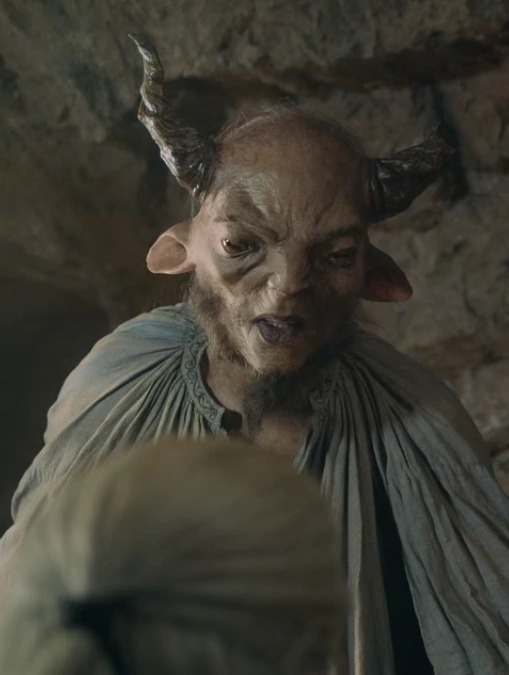
my man torque is quite possibly one of the last sylvans on the continent
they are distantly related to elves, and the two races tend to coexist quite well
generally quite mischievous and merry, highly enjoying pranks and parties. they can use simple spells and are mainly herbivores
sylvans live around 100 years and are highly sought after by dryads for their... ahem... reproductive capabilities
unicorns
yep, we got unicorns! i fucking love unicorns and still kinda think they're real. camels are real and those lumpy fuckers are way weirder than a horse with a spike on its head.
anyways
unicorns are highly advanced beings, they can travel between worlds and use telepathy. they don't really like the "less advanced" races, mostly staying around to observe them. they have distinct societies led by a council of elders and tend to avoid evil
these unicorns are badasses
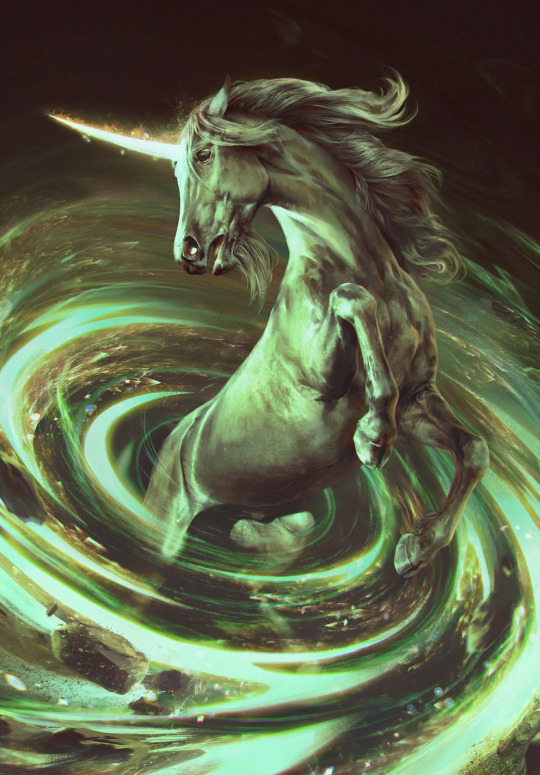
unicorns strongly despise the use of the force but encourage the power of destiny. in the context of pavetta's betrothal feast, a unicorn would not be happy with pavetta's little source hurricane thing, but would encourage geralt to follow the law of surprise
in of the witcher, unicorns are very important because of their world-hopping capabilities. the aen elle, unfortunately, realized this and began enslaving unicorns to help them plunder other worlds. this turned into a massive conflict between the unicorns and elves.
#the witcher#twn#witcher netflix#witcher lore#geralt of rivia#geralt x yennefer x jaskier#geraskier#yennefer x jaskier#wild hunt#yenskier#geraskefer#geralt x jaskier#yennefer of vengerberg#emiel regis rohellec terzieff godefroy#witcher 2#tw3#tw2#lambert#eskel#kaer morhen#mine#gen tag#lore tag#haven't got a fucking queue
160 notes
·
View notes
Text
i have worldbuilding thoughts for the dsmp and i was going to illustrate them like an encyclopedia but i didn’t like how it turned out so i’m just sticking the text here
demons are creatures born from the Void between dimensions. when an interdimensional portal is left open for an extended amount of time, Void seeps out and assumes a corporeal form. a demon's natural form is a vaguely humanoid collection of black smoke, with 2-4 horns on their "head" and white, glowing eyes. demons are capable of shapeshifting, and may assume whatever form they choose. many demons choose to go "undercover" as a member of another species.
demons possess a number of supernatural abilities, including telekinesis, flight, and the ability to create objects from Void. other supernatural beings such as Gods often consider them rivals, as Gods can be protective of their territory and often do not look kindly upon those who interfere. a demon who wishes to live in a God's territory may choose to pledge their servitude to the God to ensure their own safety.
alternatively, a powerful enough demon may be able to earn a God's respect and work with them side by side.
nymphs or dryads are manifestations of naturally occurring things in nature. the size and nature of the power source determines the nymph's strength; a dryad tied to a single flower will have significantly less power then a nymph with dominion over an entire river.
in some cases, typically with flora, a dryad will be tied to multiple of the same plant. for example, an oak tree dryad may be tied to an entire grove, or a daisy dryad, to an entire meadow of daisies. in these cases, it is significantly harder to kill the dryad as their source of power is much more spread out. however, destroying individual pieces of it (cutting down the trees, for example) will weaken them significantly.
a nymph's appearance is humanoid, and ties together elements from their power source and from an animal found in nature nearby, such as a fish or a deer.
if a dryad's power source is destroyed, they may choose to inhabit or "possess" a nearby object, although by severing ties to their previous source, they lose any power they may have held over it. alternatively, and much more difficultly, a dryad may change their power source to another object or being. in tying their essence to that other source, their life is bound to it as well; if one dies, so does the other. because of the risks of this act, it is exceedingly rare, and only done by those incredibly dedicated.
Gods are primordial beings, remnants from before the world split into three dimensions. they possess immense power, the nature of which changes depending on the god. while all gods have powers in common- summoning, teleportation, telekinesis, to name a few-- the specific powers change depending on the god's specialty. for an example, the Sky God may have the power of flight, as well as dominion over sky-dwelling creatures, while the Sea God controls the waves and the creatures beneath them.
Gods often also choose a domain or patron city to rule over. this can be unclaimed or claimed land. the God protects the area and its inhabitants, in exchange for devotion. in very rare cases, a God may allow its inhabitants to worship other deities, but this allowance usually comes with conditions.
many Gods will choose specific devotees to be their patrons. the devotee will be granted a small amount of the God's power, in exchange for servitude. depending on the God, this agreement may have certain side effects.
30 notes
·
View notes